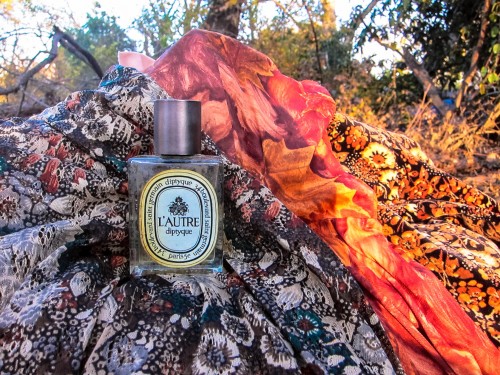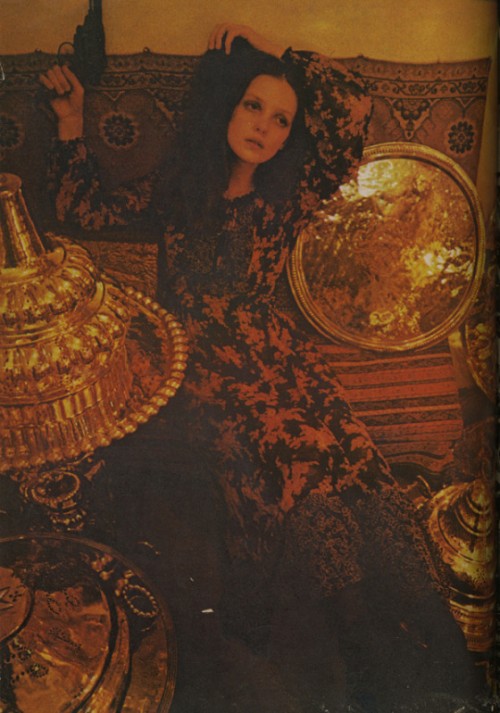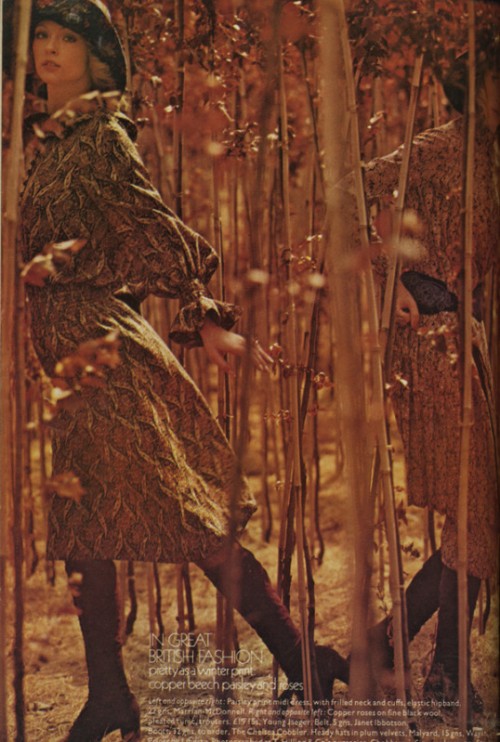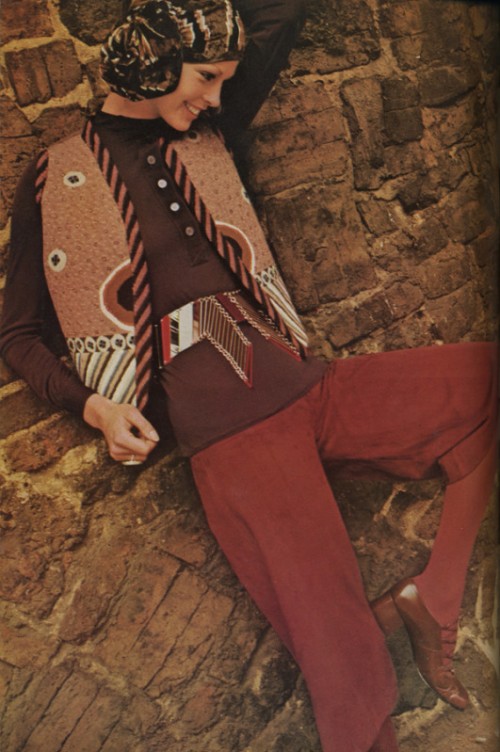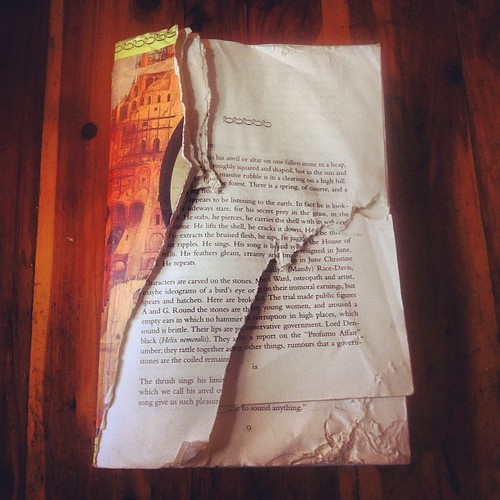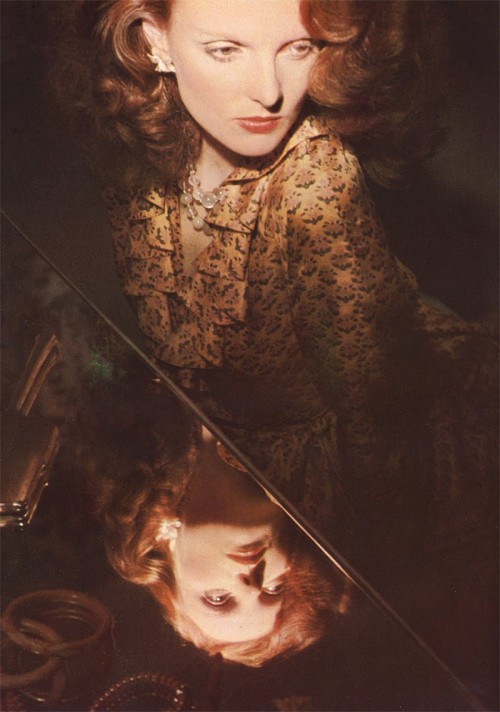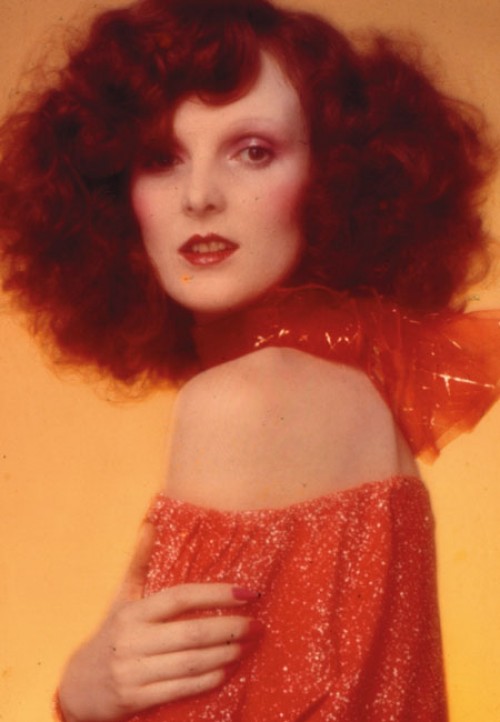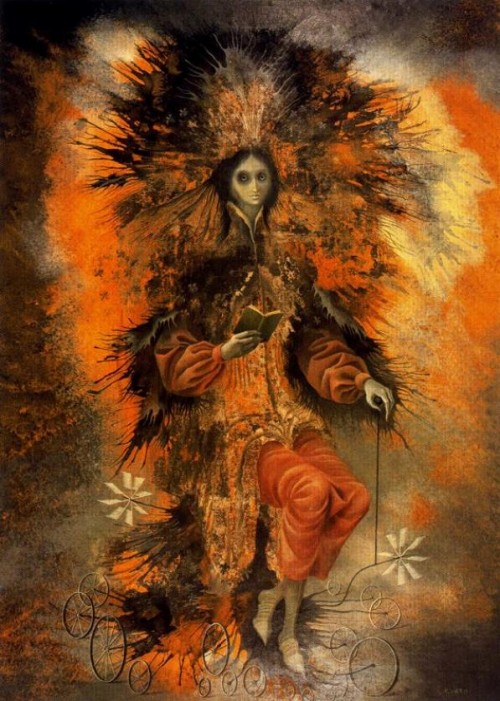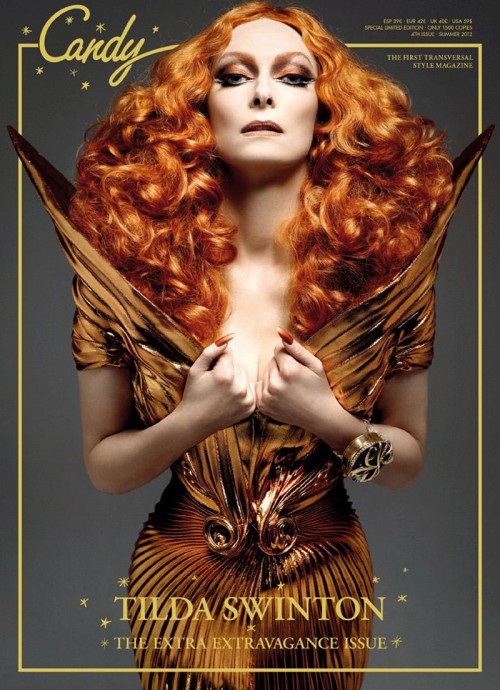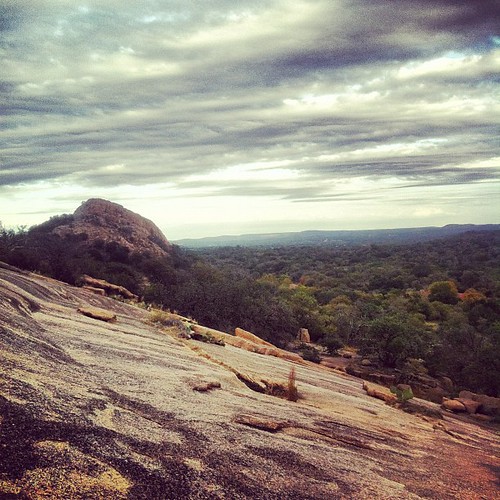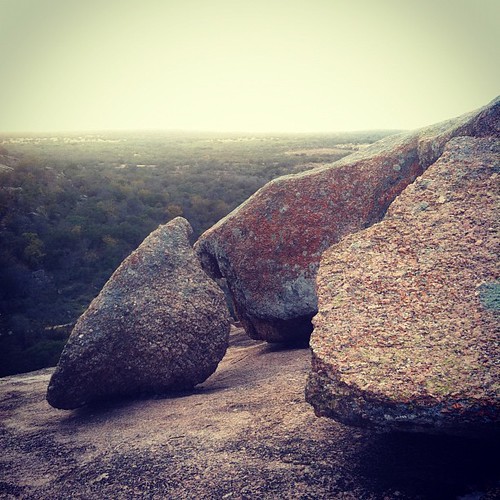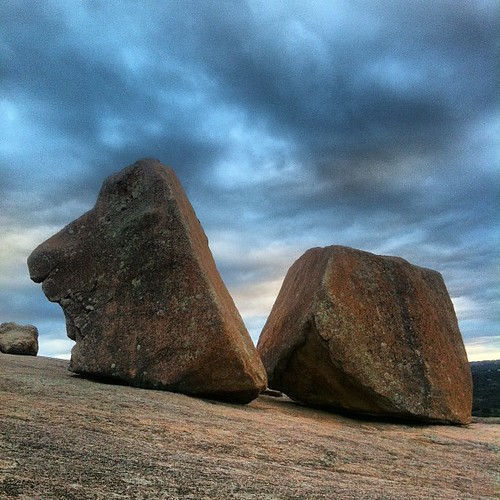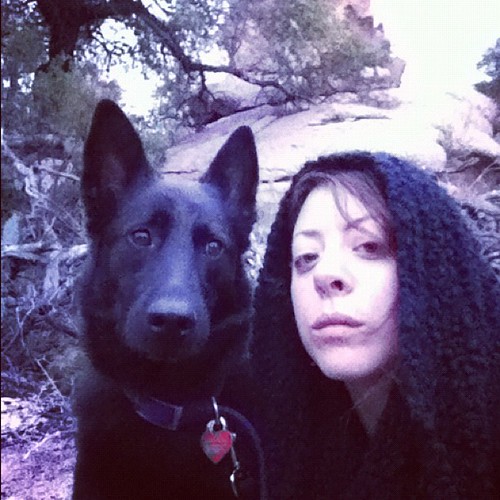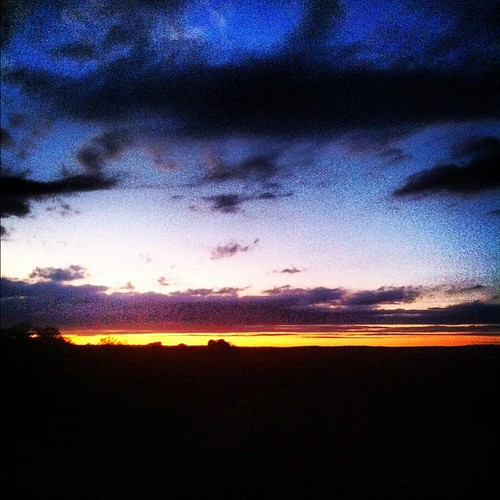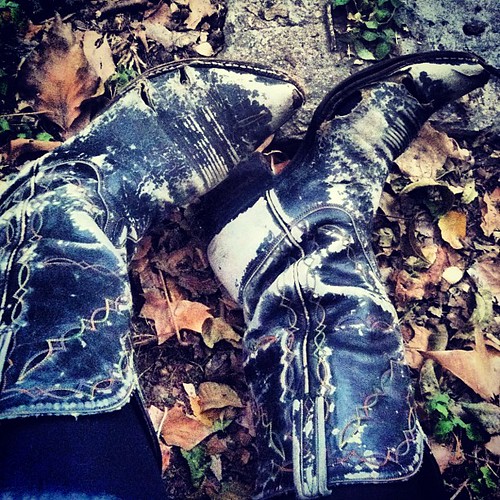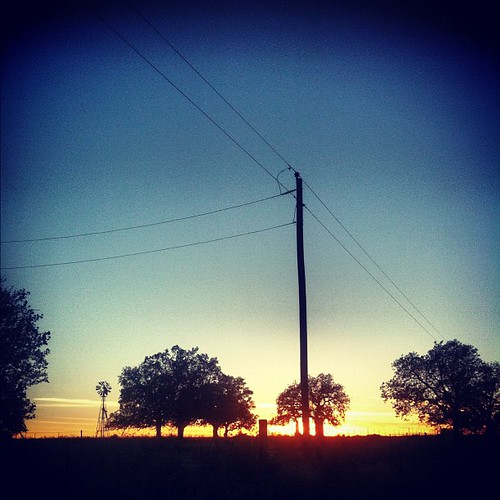12th Night Parades
by angeliska on January 4, 2013
It is with great excitement and shivery anticipation that I bear news of the rebirth of a very old tradition here in my hometown: a cadre of dear ladies and myself have joined forces as Krewe du Bisoux to bring the celebration of 12th Night to Austin. Our inaugural parade and fête will feature a decadent Kings and Queens Ball, with king cake (bien sûr!), our favorite marching band, and lots of glitter and revelry!
There’s a great article about what we’re putting together at The Gay Place:
12th Night Austin Rolls Out – The official, traditional kickoff to Mardi Gras comes to town

The celebration of Twelfth Night dates back to medieval England, and marks a turning point between the midwinter festival that begins with Halloween and ends as the Carnival season begins to fire up. Carnival means “farewell to the flesh”, and is a time of wildness, indulgence and celebration leading up to the final day of ultimate decadence before the austerity of Lent: Mardi Gras Day! Saturnalia and Bacchanalia were both celebrated in pagan Rome as lusty and decadent free-for-alls that involved excessive quaffing of wine, rich dishes, costumery, and all sorts of naughtiness. The darkest part of the year, in ancient times, required much merrymaking and fun to keep spirits bright during harsh winters that often brought much hardship. The twelve days of Christmas begin with Christmas day, and end on the Twelfth Night, or Epiphany. The end of the Winter Solstice season is ideally celebrated with a sense of triumph – that we made it through, that we survived to see another year! What better excuse for dressing up and dancing in the streets? Eat, drink, and be merry was their motto – and we’ll be trying our best to celebrate by that maxim, along with the Cajun French phrase you hear around Mardi Gras time in Louisiana: Laissez les bons temps rouler! – or: Let the good times roll!
In New Orleans, Twelfth Night is celebrated with king cake parties and, on a larger scale, Masquerade Balls. It is the night that the big Mardi Gras Krewes crown their King and Queen. On a scaled down version, house parties celebrate their own “king,” depending on who finds the plastic baby hidden in their slice of king cake. Tradition has it that the person to find the baby in their cake is rewarded with good luck for the year to come, and also is obligated to host the next king cake party before the season is over. Before plastic babies came into vogue In times of yore, a bean or a pea was hidden in the cake – the Bean King and the Pea Queen preside over the year’s festivities. It was custom for this day to be a time for everything to be turned on its head: to crown the peasants as kings, and for the royalty to run rampant in rags. On Twelfth Night, the Lord of Misrule dictates that everyone must come as they are not – the practice of dressing up in costumes or hiding one’s true face behind a masquerade mask is really a kind of ritual mummery that is practiced in ceremonies and magical rites in many cultures. When we dress in costume, we are given the freedom to become someone else – to enact fantasies, totems or characters from the deepest recesses of our psyches. It may seem to be nothing more than frivolity, but in truth, mummery can be a powerful form of catharsis for our spirits. Also, it really is a whole lot of fun!
Parades and processions have long been part of this celebration – taking to the streets in wild ensembles with noisemakers, instruments, pots and pans to bang on, (or even better – a marching band!) is another symbolic way of turning our every day sense of reality around. Houses and businesses that we might walk or drive by on any normal week are suddenly made more mysterious and special when we dance and frolic past them in a wild parade. It’s a form of reclaiming public space, of taking back streets and sidewalks that are usually only used in typical workaday fashion, and celebrating there. There’s something very magical about gettin’ down to a brass band in the middle of the street – a certain kind of freedom that’s not quite there in an enclosed space, or a venue dedicated to that purpose. We want very much to share that experience with Austin, and create a new tradition to help us all bring a bit more magic, dazzle and joy into our city!
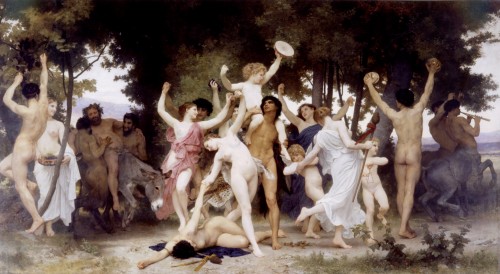
La Jeunesse de Bacchus (1884) – William Adolphe Bouguereau
I’ve been reading Dancing in the Streets – A History of Collective Joy by Barbara Ehrenreich, which is a wonderful look at the history of parades and public celebrations through the ages. Parading is such a huge part of the way I love to express my lust for life: I am fascinated by the history of festivals, costumed processions and ritual mummery, and this book really delves into why we, as humans have always felt the need to celebrate in these ways.
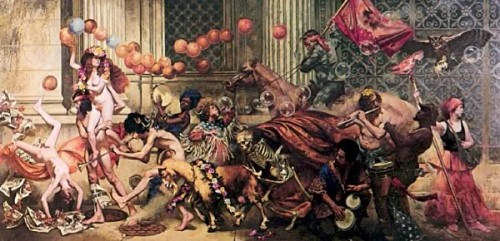
I discovered the artwork of Harvey Dinnerstein via Matthew D. Innis’s excellent art blog, Underpaintings, and I am so grateful to him for introducing me to Dinnerstein’s work. I bought both books of his paintings after reading that article! Also, Innis has collected some of my favorite paintings with a processional theme in his post – the Alma-Tademas and James Gurney dinosaur parades I adore especially. One of Dinnerstein’s masterpieces, Parade, was painted in 1972, and I have found myself completely captivated by it.
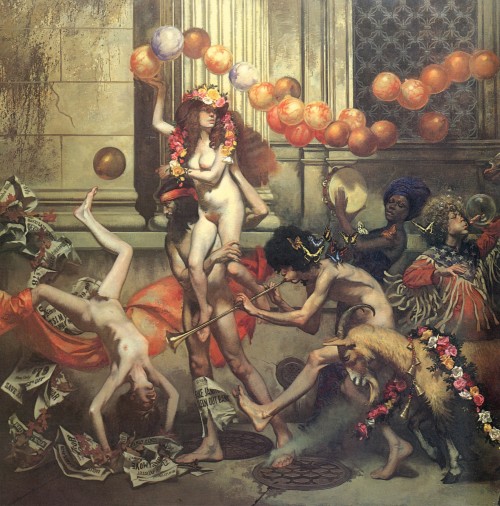
From Underpaintings:
Of creating Parade, Dinnerstein said, “I had in mind a processional image, somewhat like the reliefs of Roman sarcophagi, related to Reubens’ development of similar themes. I have a memory of an experience viewing Delacroix’s Death of Sardinopolis at the Louvre. When you place yourself at a distance from the painting, so that the range of your vision encompasses the width of the image exactly, there is a dazzling effect of movement, and I hoped to arrive at some of that kind of energy in my painting.
and
With his work, Parade, Dinnerstein sought to emulate the grand allegorical paintings of the Renaissance, but from the Naturalist viewpoint which made up his training. He found in the political demonstrations of the sixties, a use of symbolism and myth by the protesters from which he could create his own epic image. From his own notes and sketches made during his personal observation of that tumultuous time, Dinnerstein engineered this spectacular piece.

A parade is a reminder to sing and dance while we may! I plan on doing as much of that as I can in this life, and I can’t think of a better way to ring in a new year and the start of Carnival than by celebrating 12th Night! If you’re in Austin, please do join us, and if not – well, get yourself a pan to bang on, a banner and a band and start your own parade wherever you may be!
New Year's Eve Foxfires at the Changing Tree
by angeliska on December 31, 2012
The turning of year draws close, we pause, here at the limen between what’s done and what’s to come – the snake’s lips meet its own tail and we ride the circle, blind and naked as babes. The reflexive curl inward, a protective gesture towards completeness: to be a whole and finished being, perfect and inviolable. But I’m not. There is so much left undone and unresolved that I have to just accept – to keep rolling onwards into the new dawn as calmly as I can, trusting that in time I will find a way to mend the broken things, understand the heart’s riddles, knit together what’s unraveled and do the rest of the work. That process is never really completely done though, I think. Nothing’s ever as tidy or as comprehensible as we might like, and I want to be able to sit with that as much as I can: to move forward into the unknown trusting somehow in that essential unknowableness. The ouroboros is the end and the beginning, alpha and omega. I always associate it with the final card in the the tarot: The World, which symbolizes the completion of the journey of The Fool, the moment when he dissolves and becomes one with everything. Solve et Coagula. When the Fool is reborn, the journey begins again – not with one, but with zero. Another circle, a goose egg, an ouroboros. This loop is everything, our eternal return, our journeying that is never finished, always beginning. I feel like I’m starting over like The Fool this year, my arms open, ignorant of what the future holds or what I might encounter on this strange journey. I’ve lost so much this year: so many beloved people and relationships, structures, ideas, belief systems I had constructed and held fast to – more than anything, I’ve lost things I thought were concrete, permanent, lasting. But nothing is. Nothing at all. There is only this moment, and this one, and this one. This process has of course been painful and confusing in the extreme: but I have come to the point where I’m finally resting against the snake’s mouth, the place where I can see the end of the tunnel and start to grasp some of the major lessons this intense cycle has brought me. It will take time for me to work through it all, and as much as I might like to be able to sum it up perfectly right in this moment, I am forcing myself to sit still, to not push, to wait and do the work as it comes. I can honestly say that this has been absolutely one of the hardest and most brutal years of my entire life, in terms of loss and hard lessons. It’s also completely true that I’ve grown exponentially in relation to a lot of that hard change, and that I am working hard every day to be the best possible version of myself. I’ve also gained many treasures – in the form of amazing friends, family and all the people I know who are constantly inspiring me to try and be kinder, wiser, and gentler. I am deeply grateful. Even for the hardest parts – because I am learning so, so much. There is so much I still have to process about this year – I think it will take a long time to express it all the way I want to, but I do intend to try. Right now, I just want to come full circle. I want to go back to the place where my people come from, to the place where my bones will rest when all that I am is gone, I want to bring gifts of fire to the twisty black witch-oaks that burst up through the cracks in pink granite, and as best I can – honor all this change, this turning, the dark road behind me, and the shining one up ahead.
This year was a fierce thing: it burned away everything that could not last.
I am asking for a more tranquil time: to focus on fluidity, on being open, on peace.
Dragons and snakes, circles and ladders, mountains and pits, shadows and stars.
Come, let’s light the foxfires.
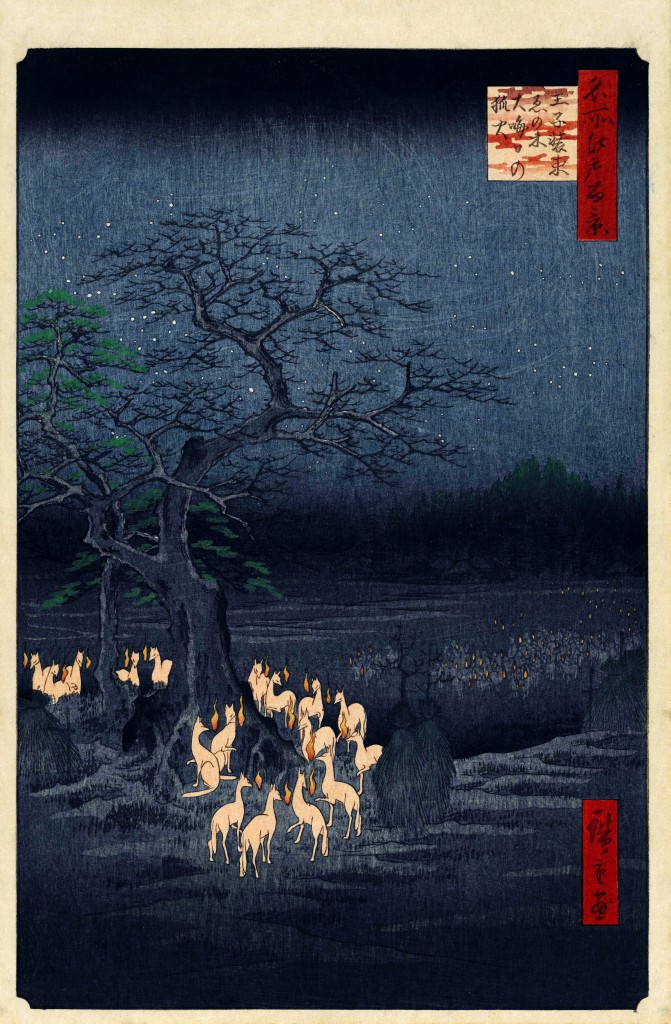
New Year’s Eve Foxfires at the Changing Tree, Oji, 1856-1859
by Ando Utagawa Hiroshige
A Japanese woodblock print of Hiroshige from 1857 depicts fox Fires on New Year’s Eve at the Garment Nettle Tree at Oji. According to Japanese legend, trickster fox spirits gather once a year at night at an old tree at the Oji shrine, bearing torches, to receive their orders for the following year. One of the two trees depicted can still be seen.
Hiroshige was a favorite of my Grampa’s. He gave me several books of his prints before he died.
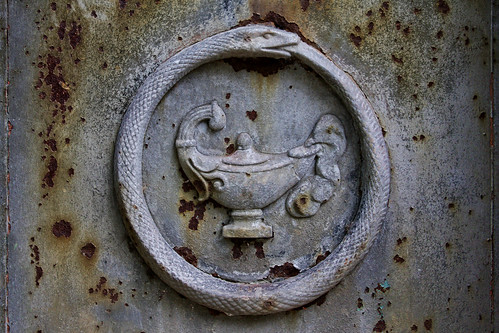
Ouroboros (Uroborus) with lamp by Leo Reynolds
The Ouroboros or Uroborus is an ancient symbol depicting a serpent or dragon eating its own tail.
The Ouroboros often represents self-reflexivity or cyclicality, especially in the sense of something constantly re-creating itself, the eternal return, and other things perceived as cycles that begin anew as soon as they end (compare with phoenix). It can also represent the idea of primordial unity related to something existing in or persisting from the beginning with such force or qualities it cannot be extinguished. The Ouroboros has been important in religious and mythological symbolism, but has also been frequently used in alchemical illustrations, where it symbolizes the circular nature of the alchemist’s opus. It is also often associated with Gnosticism, and Hermeticism. Carl Jung interpreted the Ouroboros as having an archetypal significance to the human psyche. The Jungian psychologist Erich Neumann writes of it as a representation of the pre-ego “dawn state”, depicting the undifferentiated infancy experience of both mankind and the individual child.
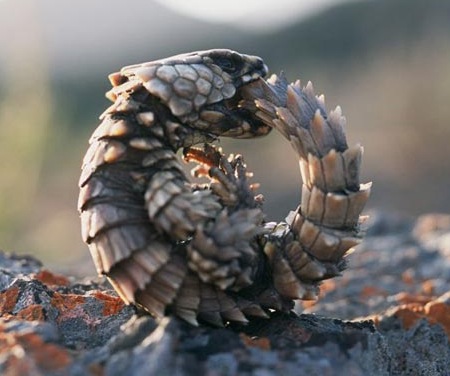
“The armadillo girdled lizard possesses an uncommon antipredator adaptation, in which it takes its tail in its mouth and rolls into a ball when frightened. In this shape, it is protected from predators by the thick, squarish scales along its back and the spines on its tail. This behavior, which resembles that of the mammalian armadillo, gives it its English common name. This behavior may have inspired the mythical creature Ouroboros.”

Ouroboros – The Lion and the Snake by Wiertz Sébastien
“Plato described a self-eating, circular being as the first living thing in the universe — an immortal, mythologically constructed entity.
‘The living being had no need of eyes because there was nothing outside of him to be seen; nor of ears because there was nothing to be heard; and there was no surrounding atmosphere to be breathed; nor would there have been any use of organs by the help of which he might receive his food or get rid of what he had already digested, since there was nothing which went from him or came into him: for there was nothing beside him. Of design he created thus; his own waste providing his own food, and all that he did or suffered taking place in and by himself. For the Creator conceived that a being which was self-sufficient would be far more excellent than one which lacked anything; and, as he had no need to take anything or defend himself against any one, the Creator did not think it necessary to bestow upon him hands: nor had he any need of feet, nor of the whole apparatus of walking; but the movement suited to his spherical form which was designed by him, being of all the seven that which is most appropriate to mind and intelligence; and he was made to move in the same manner and on the same spot, within his own limits revolving in a circle. All the other six motions were taken away from him, and he was made not to partake of their deviations. And as this circular movement required no feet, the universe was created without legs and without feet.’
In Gnosticism, this serpent symbolized eternity and the soul of the world. The Gnostic text Pistis Sophia describes the disc of the sun as a 12-part dragon with his tail in his mouth”

Sergei Sergeivich Solomko (1867-1928)
I want to sleep and dream in the crook of the changing tree. I’m ready to become a different kind of bird. I feel like this coming year is already sparkling and crackling with possibilities.

Ouroboros – by Jason Brammer
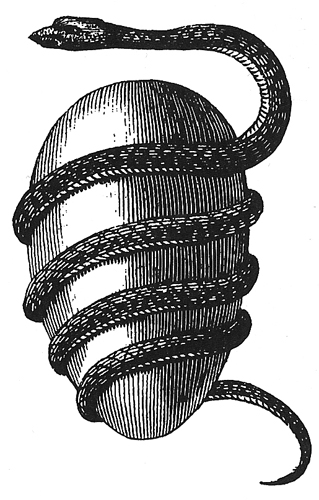
The Orphic Egg
The egg symbolizes the belief in the Greek Orphic religion that the universe originated from within a silver egg. The first emanation from this egg, described in an ancient hymn, was Phanes-Dionysus, the personification of light. In Greek myth, particularly Orphic thought, Phanes is the golden winged Primordial Being who was hatched from the shining Cosmic Egg that was the source of the universe. Called Protogonos (First-Born) and Eros (Love) — being the seed of gods and men — Phanes means “Manifestor” or “Revealer,” and is related to the Greek words “light” and “to shine forth.” An ancient Orphic hymn addresses him thus: “Ineffable, hidden, brillian scion, whose motion is whirring, you scattered the dark mist that lay before your eyes and, flapping your wings, you whirled about, and through this world you brought pure light.”
This year, I’m headed back out to Lone Grove, to the place where I traditionally prefer to ring in the New Year.
My dear friend Chip Warren is a wonderful photographer who captured so much magic during our celebration in 2011 –
he made this fantastic video to give you an idea of what it was like that year.
His full set of New Year’s Eve 2011 photos are here:
Lone Grove New Years 2011
More words of wisdom from my comrade Dr. Caraway: Ambling in the new year
Some musical mixes from myself and from Lau to honor the turning of the year:
More to read from New Year’s Eves of yore:
✶ FUCK THE PLAN 2012
✶ AN EPICALLY EPIC AND FAIRLY TARDY YEAR IN REVIEW – OR, HOLY SHIT: 2011!
✶ A Bright Blue Wish
✶ New Year’s Redux
✶ Stargazer Honey
✶ Blue Moon
✶ Lone Grove New Year
✶ Pink Moons
✶ The New Year
✶ Lucky Stars and Garters
✶ La Nouvelle Année
Winter Solstice – Bright Stars + Firelight
by angeliska on December 20, 2012
The winter solstice is nearly upon us – this one so trepidatiously anticipated as a harbinger of either the end of the world, or the beginning of a new era of human conscious – depending on you talk to. For me, this is a moment to stop, to take a deep breath, to light a fire. I want to nestle in my little nest, to gather friends and beloved animals around me, to sip mulled wine and burn away everything I am ready to let go of. The solstice is a time of wonder, of ritual, of candles lit under shivering stars.
I found a wonderful book recently that has been very inspiring reading as I’ve been preparing my celebration. I’ve included some illustrations and excerpts from it here in this post:
The Winter Solstice: The Sacred Traditions of Christmas
by John Matthews (with contributions from Caitlin Matthews).
I love this excerpt from the introduction:
“The Solstice is a time of quietude, of firelight, and dreaming, when seeds germinate in the cold earth, and the cold notes of church bells mingle with the chimes of icicles. Rivers are stilled and the land lies waiting beneath a coverlet of snow. We watch the cold sunlight and the bright stars, maybe go for walks in the quiet land. . . . All around us the season seems to reach a standstill — a point of repose.”
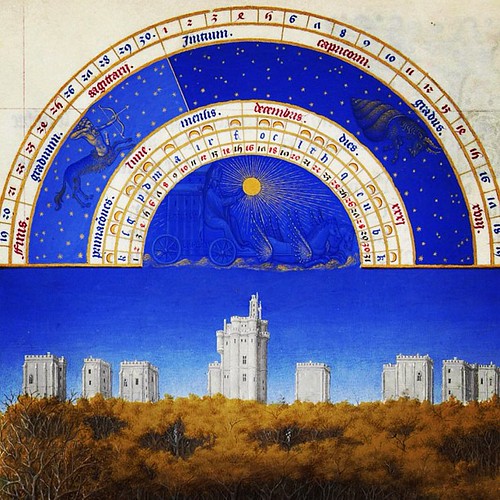
From the Très Riches Heures du Duc de Berry – one of my favorite things in the whole world.
“At this point we shall discuss the order of the steps by which the soul descends from the sky to the infernal regions of this life. The Milky Way girdles the zodiac, its great circle meeting it obliquely so that it crosses it at the two tropical signs: Capricorn and Cancer. Natural philosophers name these ‘the portals of the sun’ because the solstices lie athwart the sun’s path on either side, checking farther progress and causing it to retrace its course across the belt beyond whose limit it never trespasses. Souls are believed to pass through these portals when going from the sky to the earth and returning from the earth to the sky. For this reason one is called the portal of men, the other the portal of gods: Cancer, the portal of men, because through it descent is made to the infernal regions [to life on earth]; Capricorn, the portal of gods, because through it souls return to their rightful abode of immortality, to be reckoned among the gods.”
– From A Commentary on the Dream of Scipio, written by the medieval scholiast Macrobius (5th cent AD) The Dream of Scipio was a cosmological section of Cicero’s work, On the Republic, which did not survive as a manuscript, but was found beneath heaps of tomes in the Vatican library in the 19th century. What was found, however, did not contain the Dream of Scipio, which is only preserved in the commentray by Macrobius. Alas.
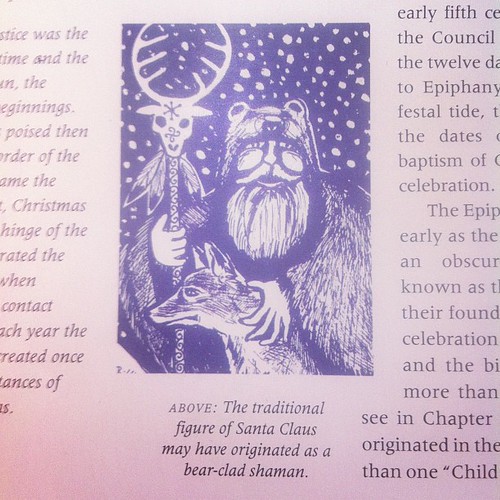
Santa was a bear shaman, y’all.
“Shaman, will the sun be reborn? Will we have a good harvest? Will we catch enough fish, will there be enough meat to eat, will the reindeer drop enough offspring to keep us through another year?
What will the new year bring for us, for me? Tell us, shaman, make your journey and bring us the gifts of your seeing!
You are the bringer of gifts, the protector, the magician, the future is yours to see, the sack on your back carries the gifts of the future and the past — tell us, shaman, tell us.”
– Alison Mcleay
The psychedelic secrets of Santa Claus – Modern Christmas traditions are based on ancient mushroom-using shamans.

Animal disguise is part of many ritual Solstice dances and performances…
“The many animals that throng the Winter months are particularly present during the Twelve Days of Christmas, those days in which guising is performed, when we walk between the worlds, masking and veiling our features so that animal spirits can moves through us and among us, bringing their gifts and challenges. These customs embrace us all, for we are all still animals and are all part of the pattern of ancient ‘wildness’ that threads through the celebration of Midwinter.
This is itself a reflection of a once powerful but now neglected sense of oneness between human beings and the natural world that was our environment before we began to build cities and gather together in amorphous groups. That this ancient wildness is still there, only a little but below the veneer of our civilized lifestyles, is apparent by the number of traditions still in practice that involve dressing as animals and performing ancient rituals.”
– John Matthews
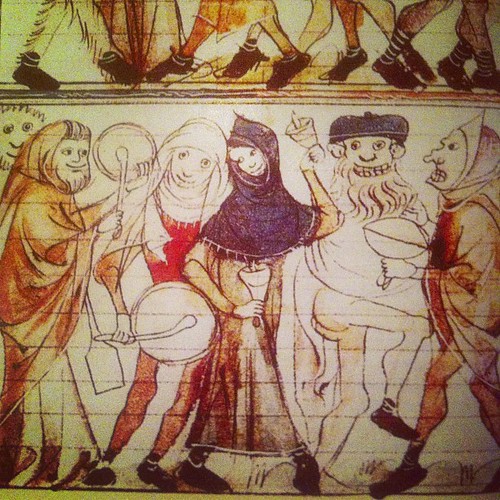
Medieval Mummery! We’ll be engaging in lots of this sort of thing this season, since we are celebrating through 12th Night with a glorious parade!
“On those days the heathen…put on counterfeit forms and monstrous faces. Some are clothed in the hides of cattle; others put on the heads of beasts, rejoicing and exulting that they have so transformed themselves into the shapes of animals that they no longer appear to be men… furthermore, it is those who have been born men who are clothed in women’s dresses…and effeminate their manly strength by taking on the forms of girls, blushing not to clothe their warlike arms in women’s garments; they have bearded faces, yet they wish to be women… ”
– Caesarius of Arles, 6th century A.D.
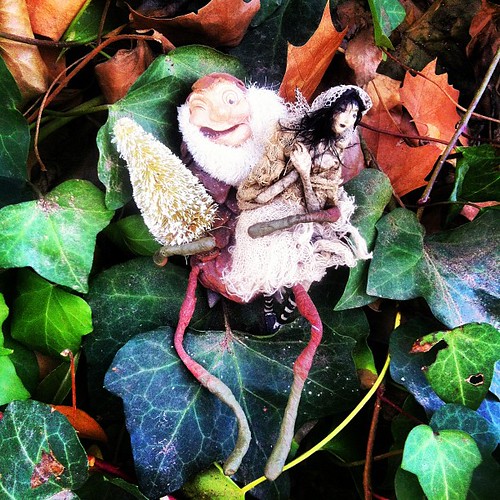
The King of Winter & an ice nymph. They are coming tonight to touch everything with frozen fingers, laughter echoing like icicles shattering.
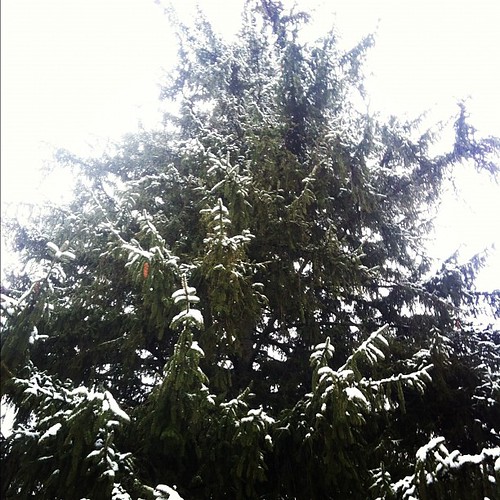
“If a cosmic tree points the way to heaven for us every Christmas, Santa Claus undertakes the magical flight of the shaman. He is sometimes said to be responsible for erecting the Christmas tree sky pole himself. Descending vertically down the chimney Santa returns by the same route back to the roof. Our chimneys, like the cosmic axis, carry him from one realm to the other…”
– E.C. Krupp, Beyond the Blue Horizon
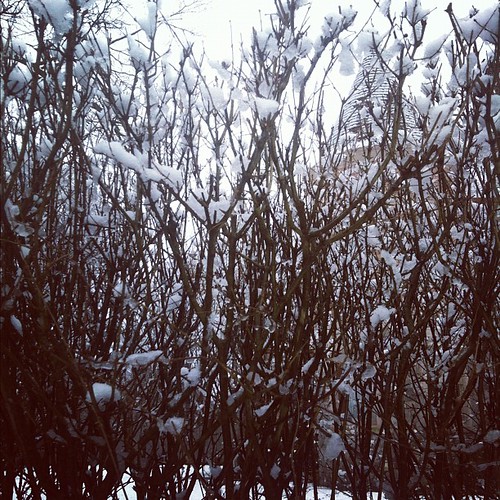
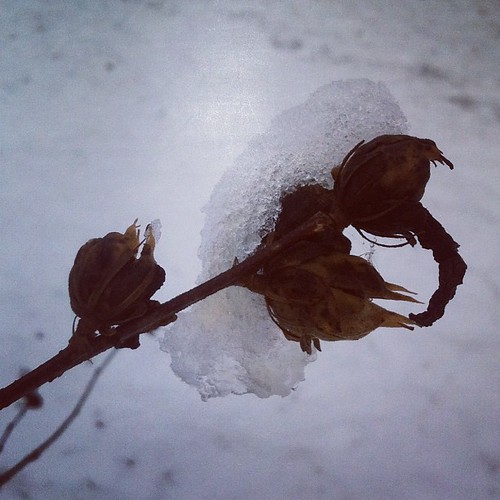
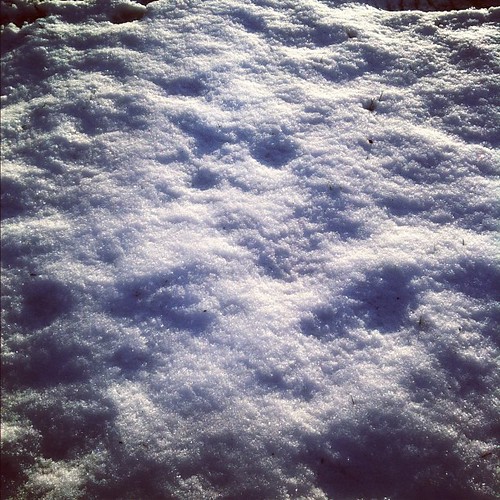
May your Winter Solstice be full of magic, hope, and wonder.
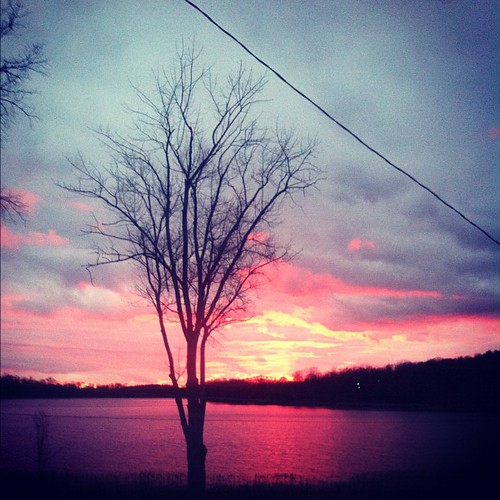
“Hope is at the very core of the Winter Solstice. There will be hunger, darkness, fear, loneliness, grief and suffering. People die, cities crumble, rivers freeze and green things wither away (except for evergreens, of course, which is why we treasure them) – and throughout it all we go on hoping that better days will come, even if we can’t imagine what those days might look like or where on earth they will come from. We go on hoping, tending the hidden suns deep inside of ourselves even as our bodies freeze, our stomachs grumble and our hearts break. We go on tending that tiny flame even after it seems reduced to nothing but cold grey ashes. We go on tending that tiny flame as if our very lives depend upon it – and you know what? They do. Our lives do depend on tending that little flame, that hidden sun. They really do, and in order to tend that flame we have no choice but to wait with it in the darkness from time to time.”
Before There Was Christmas – A Sermon by the Rev. Aaron McEmrys, delivered to the Unitarian Society of Santa Barbara, December 20, 2009
Related posts from winter solstices of yore:
WINTER SOLSTICE – BLOOD MOON
Winter Solstice – Messe de Minuit
Winter Solstice – Dark Season
Feast of All Souls
by angeliska on December 7, 2012
This year on November 2nd, which is Day of the Dead or All Souls’ Day, (also known as the Commemoration of All Faithful Departed), I was in New Orleans – a city that is on more intimate terms with death than many other cities, and a place where the dead are honored with elaborate marble necropolises, with both liturgical rites and pagan processions. The Day of the Dead parade is a tradition that I have has the great joy of participating in many times now, and has become such a major part of how I most want to honor those I’ve loved and lost every year. There’s something very powerful about this solemn, joyful, wild, rag-tag processions that wends its way through the dark streets, between houses and over train tracks, carrying ashes, lanterns, photos and memories. Every face painted with a skull, some glittered and grease painted, some intricate, some abstract. The sun set in a Maxfield Parrish blue fantasia, and we all gathered by the tracks: urchins and dogs and mamas and their little ones and elders and sisters and brothers and lovers. And the dead – invoked, unseen, everywhere.
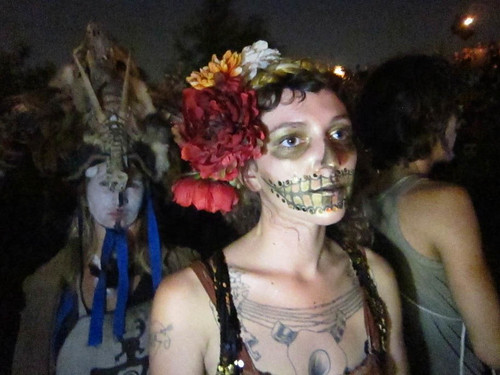
All souls laid bare, glowing and glimmering in the half-light.

Pandora makes a beautiful lantern every year for her parents.
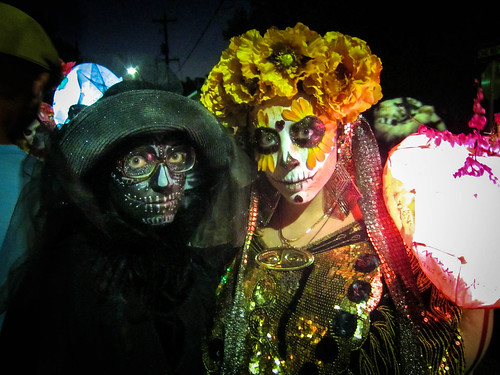
She also made a little heart lantern for me, to honor my dead. So many of them this year.
I wrote their names, garlanded them in coral vine, and carried them to the river.
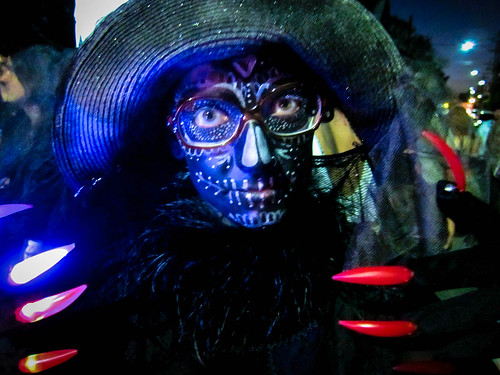
Corinne knocks me out every time.
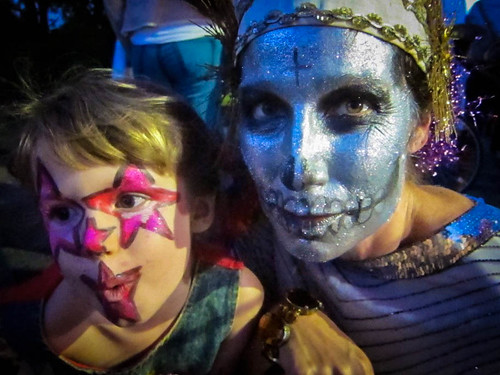
Ruby and Marcela.
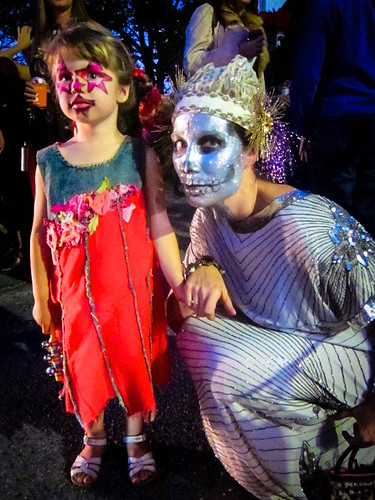
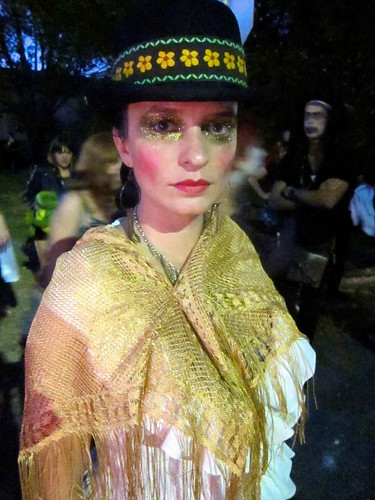
Raven as a Bolivian cholita.

Lizann shining in the streetlight.
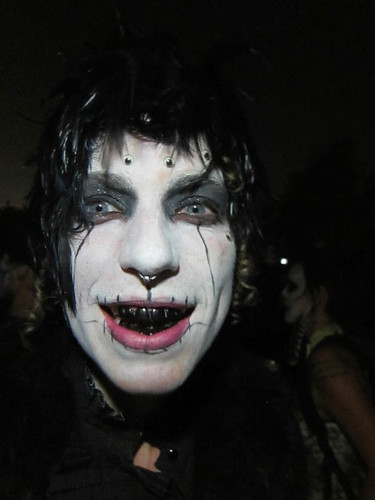
Rachel David makes me smile.
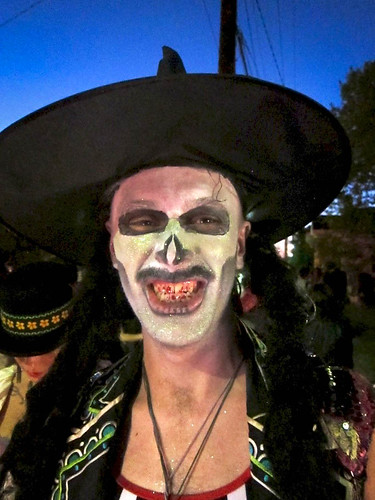
Randall Chili Frangelico is a scary witchface.
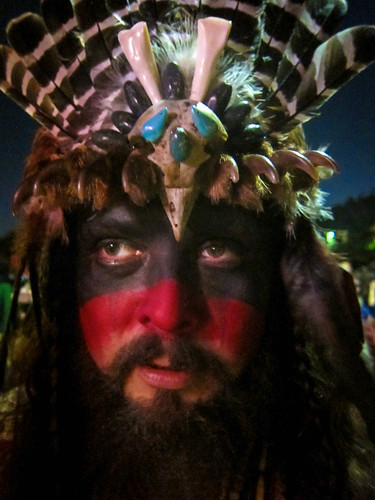
Mr. Michael James. Hot shaman.
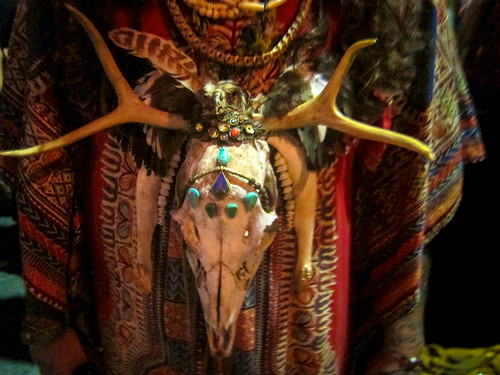
His deerskull neckpiece…
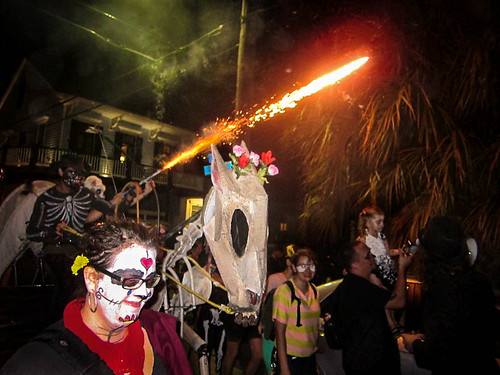
Parade! Fireworks! Dead horse wagon!
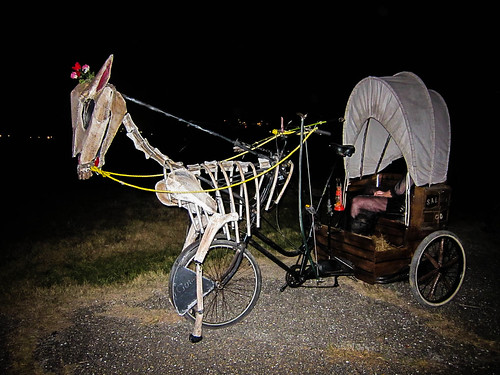
This is still maybe the best thing I have ever seen. Every time I see it, I fall in love all over again.
It moves so beautifully, clip clopping delicately down the street. Richie is such a genius.
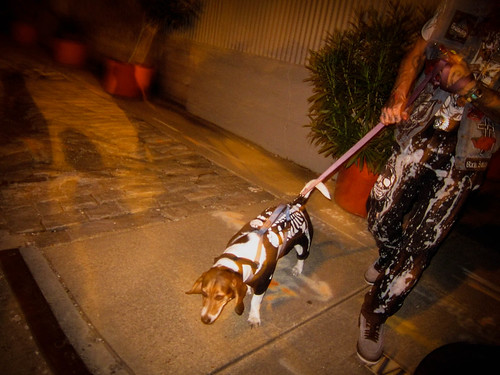
Even the doggies got dressed up.
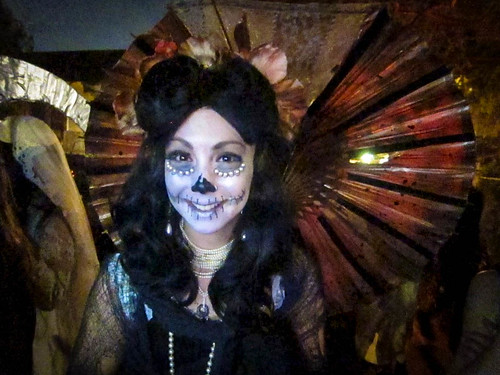
Radiant pearl.
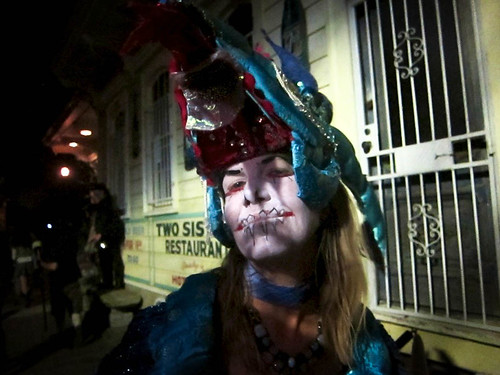
Shannon Brinkman
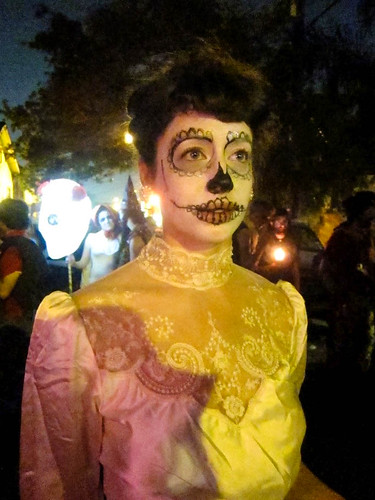
A beauty.
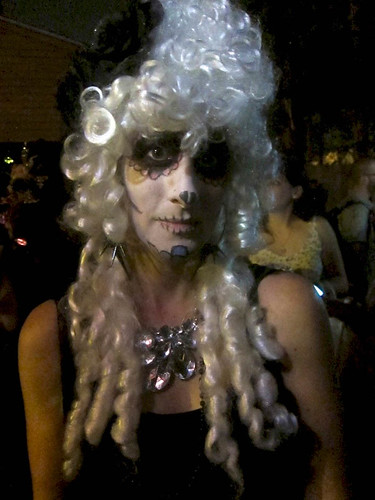
Lauren Silberman
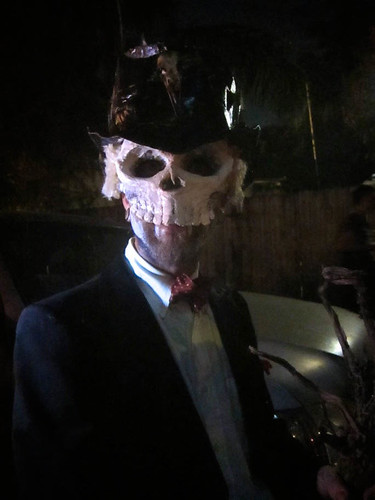
Tommy
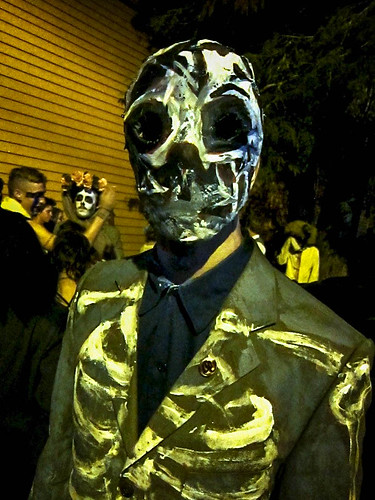
I don’t know who is under there, but I like their mask.
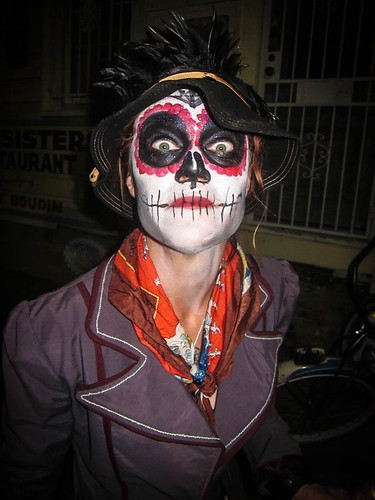
Mary Go Round
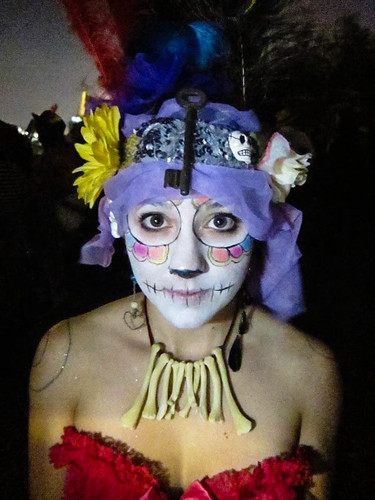
Marion
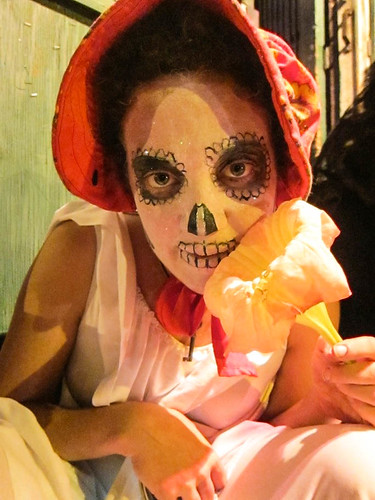
Pandora is a dollbaby.
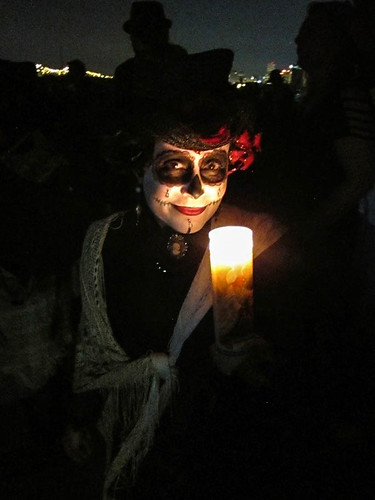
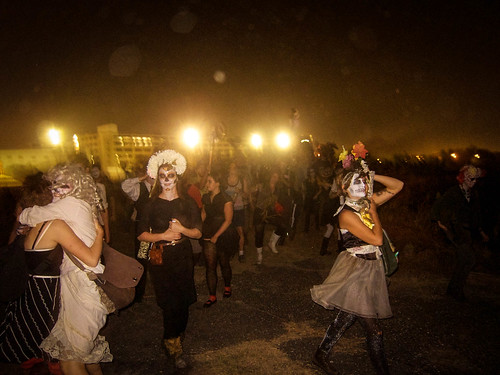
At the end of the world!
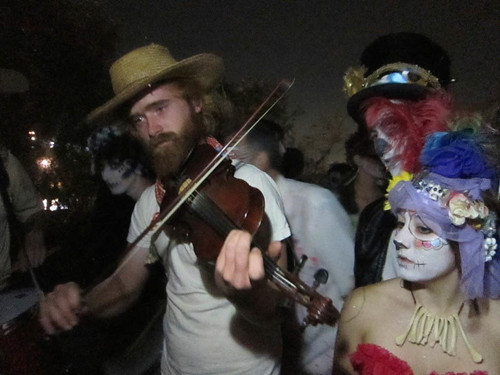
We sing while we may…
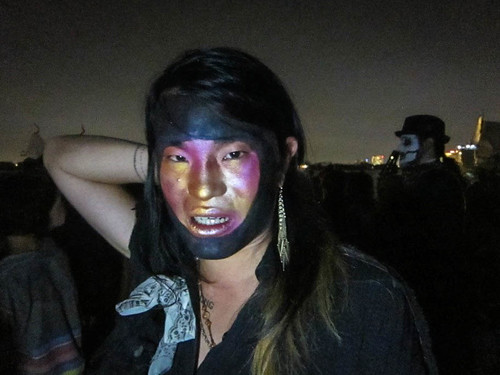
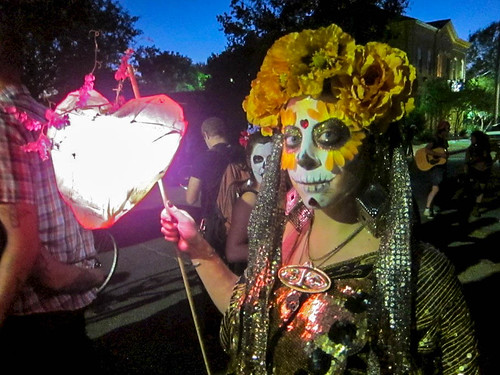
Heart in my hands, eyes lined in marigold petals, found on the ground in Rosalie Alley the night after the voodoo ceremony for the Guédé.
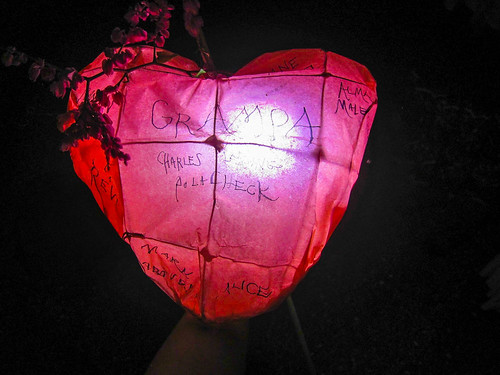
I wrote the names of these dearly departed on my heart and burned it by the river:
Charles Lessing Polacheck
Mark Aboudja
Alice Stevenson
Diane Naegel
Ray Henry Ulrich
Jennifer Cruz
Esme Barrera
Helen Hill
Jon Flee
Alma Maleckar
Nefairia Devi
Ramon
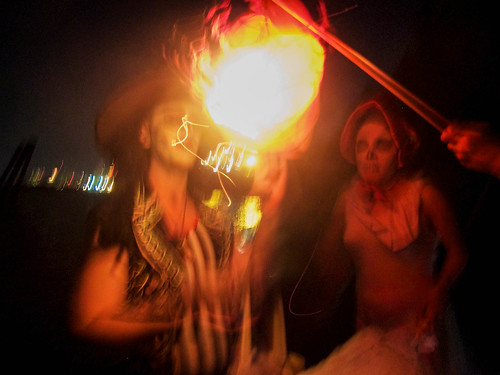
We are aflame with love, with grief, with everything in us, everything around us – catching fire, ashes drifting out to sea.
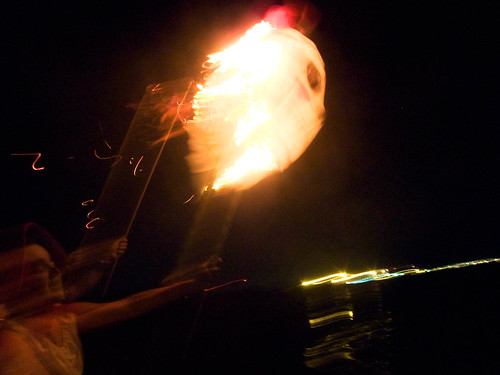
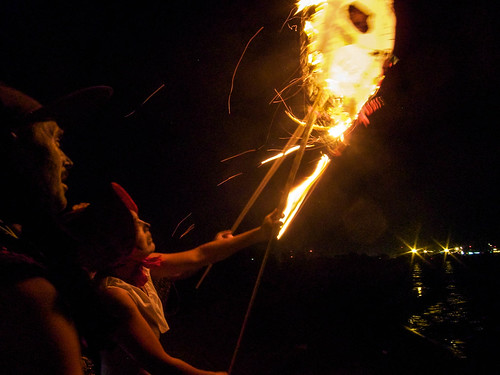
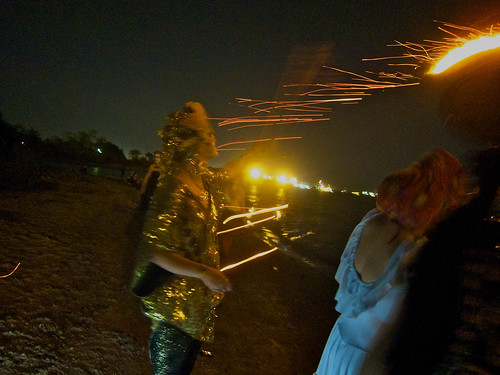
Goodbye, goodbye, goodbye.
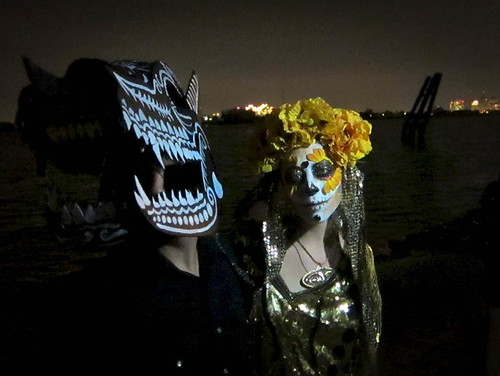
By the river, peaceful now.
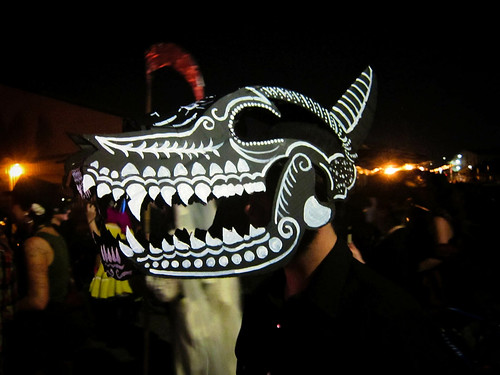
This mask was so very excellent – made from cardboard!
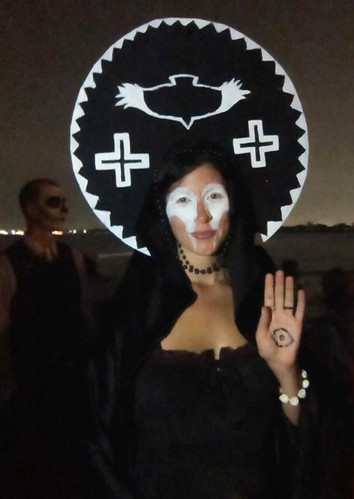
Our Lady.
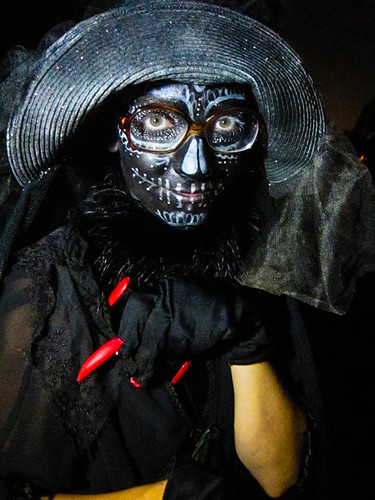
Can’t stop Corinnie!
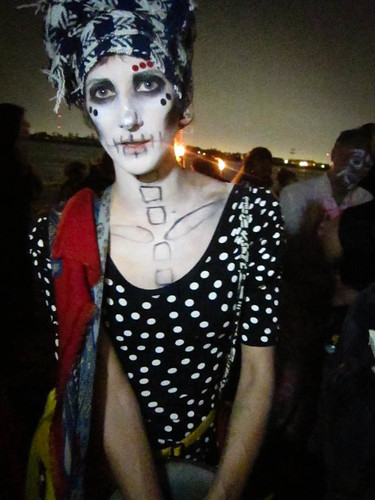
Miss Olivia LadyBabyMiss
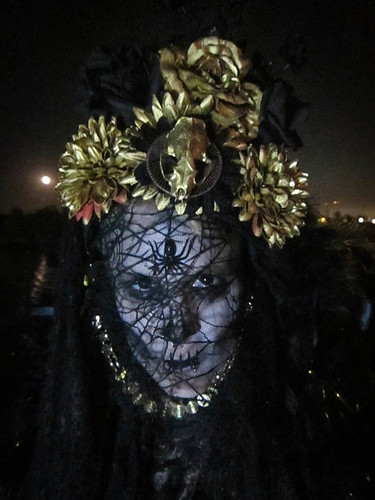
Nikki (I think?)

Antlered maiden
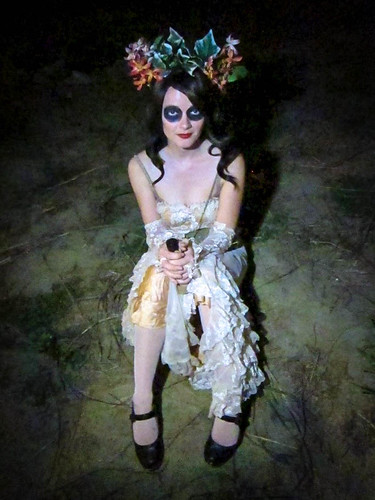
Doll girl

Star
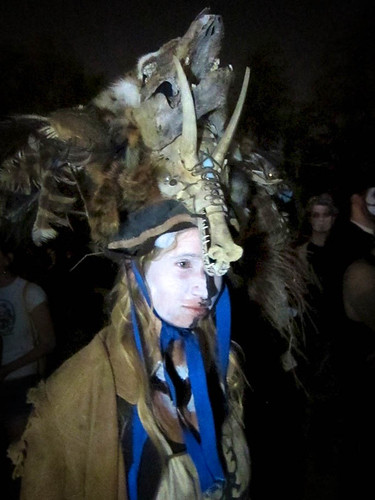
Eliza
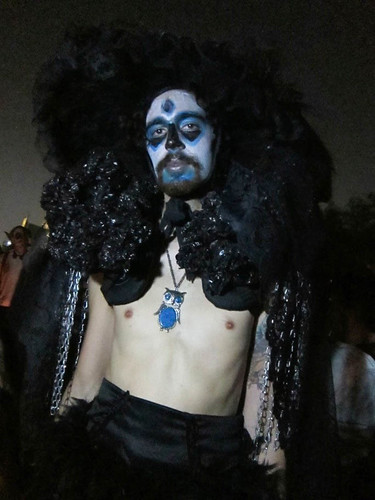
Dino

GIT IT!
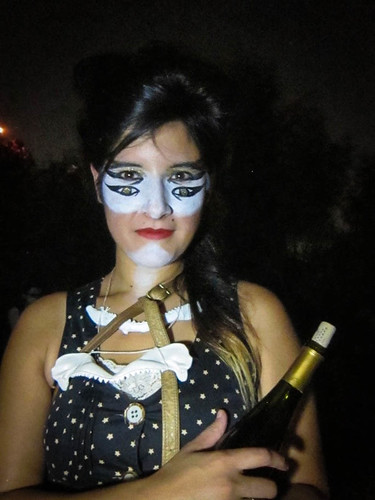
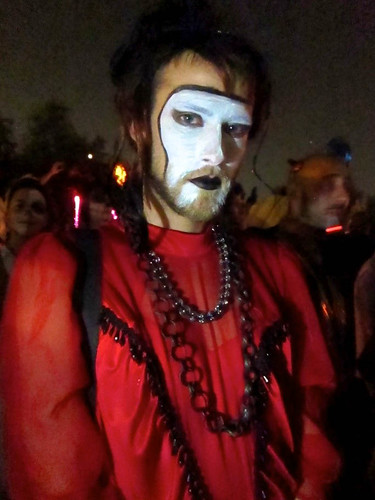
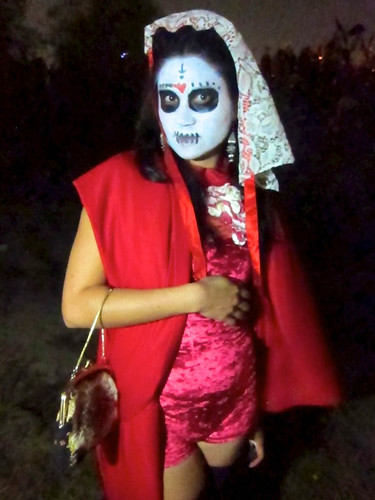
Alita Edgar
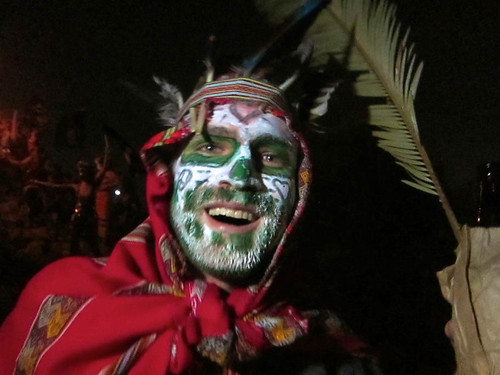
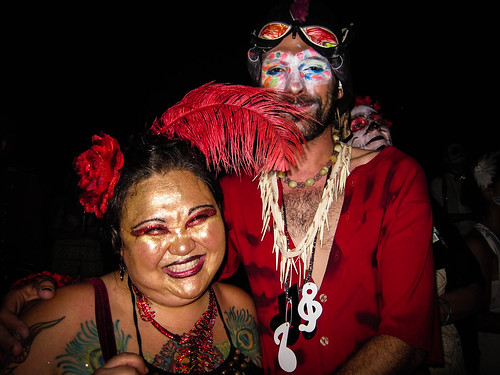
Calamity & friend.
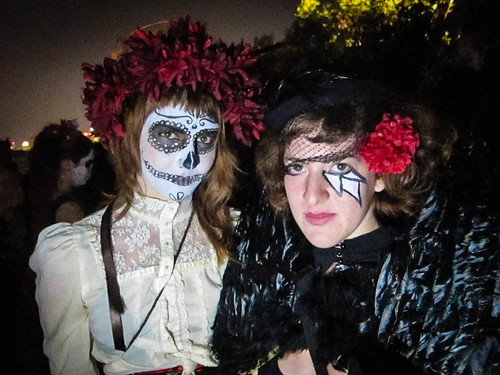
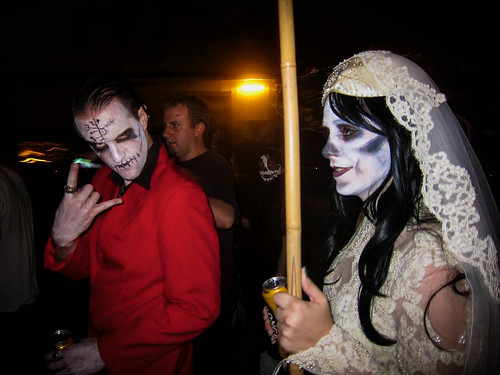
Josh + Sophia
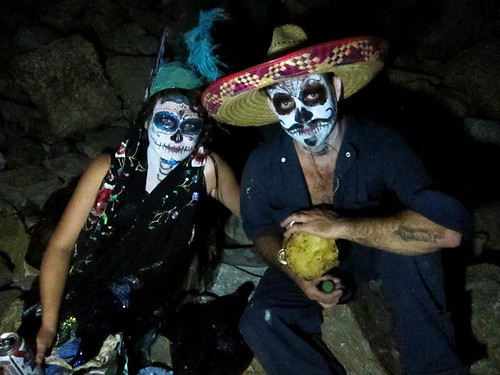
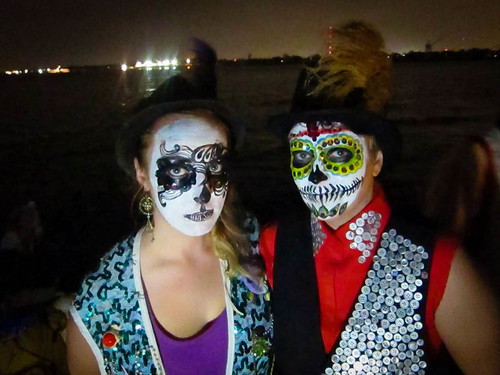
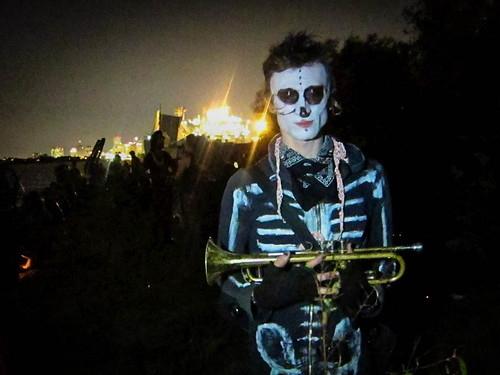
Misha
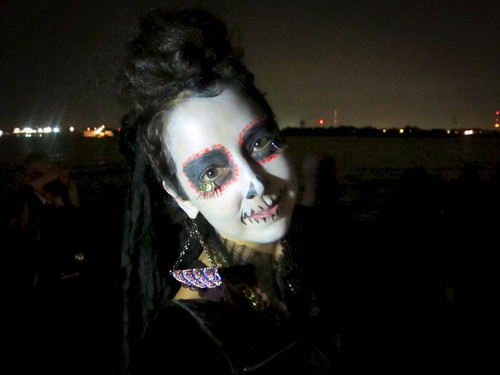
Amanda Stone
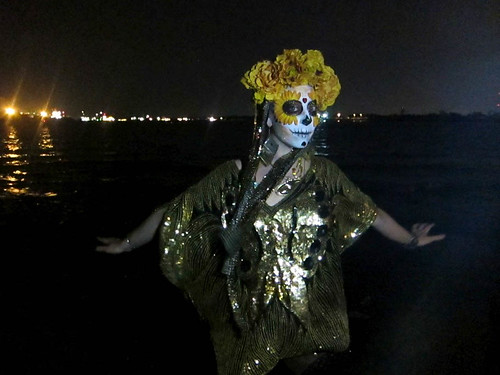
Dancing along the edge.
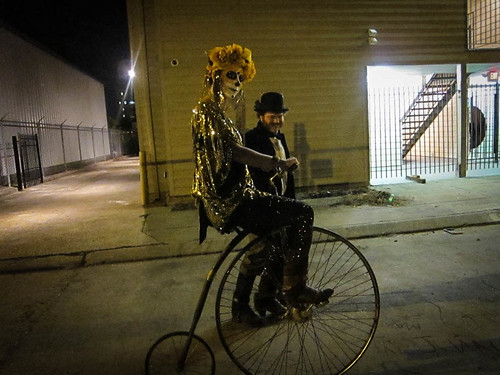
I got to ride on a nice man’s pennyfarthing!
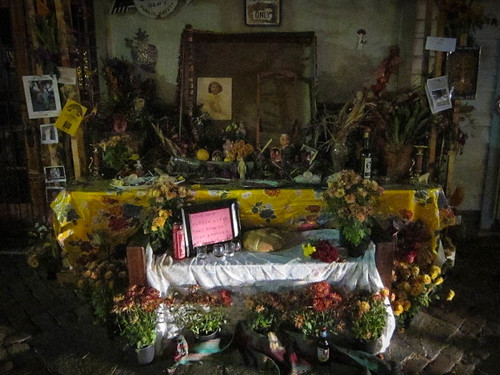
On the long walk back to the world, I came across this beautiful altar.
The sign reads: this is public altar – feel free to post photos and offerings

Folks from the neighborhood had come and added photos and memorials of their loved ones. It was strange to come across photos of people I recognized there, like My friend Felix’s dad, Hart McNee, who passed away in 2009. Strange and beautiful. I’m so grateful to be able to experience rituals like this. It is my dream in life to be able to create more opportunities for people to grieve and celebrate and honor their dead in beautiful ways like this. One day, I hope to help make a similar procession happen in Austin… Hopefully, one day very soon.
Full set of photos here:
Day of the Dead 2012
Further reading on Day of the Dead:
✂ LAS CATRINAS
✂ Day of the Dead in New Orleans
✂ Cempasúchil por los Muertos
✂ Día de los Muertos – R.I.P. Studs Terkel
✂ Santissima Muerte!
L’Autre
by angeliska on November 30, 2012
I’ve been wanting to draw this all together for awhile, ever since I found a half-full bottle of Diptyque’s L’Autre on Ebay last year. It’s a scent I’d been hearing tale about for years – one that intrigued me since it is so often reviled as being too weird, or too stinky. Being a Capricornian sea-goat, I tend to savor a good ripe stink – if it’s the right kind… I find the funk of the Indian spice asafoetida to be strangely pleasing, and the animal musk of certain armpits have been known to drive me to fits of wild nuzzling, like a truffle-hunting boar. It’s the faun in me, the forest dweller that loves to roll like a wolf in rotting piles of leaves and mushrooms. Even the smell of roadkill on a breeze isn’t always initially repulsive to my nose.
So, I instinctively knew that I might adore L’Autre, the Other – that naughty satyr trapped and gamboling in a glass bottle. There are so many perfumes I find truly abhorrent – but most of them are cloying, sugary synthetic concoctions meant to mimic the juice of carefully engineered robotic fruit, and usually worn by desperate women attempting to buy a renewed sense of juiciness at the mall. I’d literally rather slather myself in the ooze from a dead raccoon or be sprayed by a skunk before allowing myself to be spritzed with some eau de mango whale-butt. I’m serious.
L’Autre is a woody blend of spices including cumin, coriander, cardamom, carvi and patchouli, that for me, evokes a certain place in time: an autumn in London circa late 1960’s/early 70’s. There’s something about the spice over a coolness, a stoniness. It’s an old English rock-wall draped in dry moss, with an orange paisley scarf flung over it, forgotten by a hippie couple, who bought it in India, and used it many times to couple on, to serve lentil picnics over, to wrap around their attar drenched necks.
It’s the scent of an irrevocably civilized person who travels, and seeks out the exotic, and forces themselves to be alright with not bathing while on their voyage. Perhaps I’m reading too much into it, but I can’t help feeling that the wildness and naughtiness in it are made even more exciting when paired with a certain staidness. It’s a deceptively calm, pale face with a ribald glint in the eye. It makes me think of cold British weather made cozy indoors with spicy stews and tea and tapestries and incense and sex. All the very best things about autumn. It’s perfume for the moment when the sixties really started swinging, and the Beatles and Donovan all went to hang out with the Maharishi.
It’s Norwegian Wood: all sitars and aching blue balls and wine spilled on the persian rug. At least, that’s my interpretation. I don’t feel right putting it on unless I’m wearing something rusty, sable or saffron. It makes me want to dress in a russet leather trenchcoat, or in old riding gear. It makes me want to tumble on a lambskin rug in front of a fire with someone wild until winter’s over.
My dwindling bottle perched on an assortment of my favorite fall patterns. Two frocks, and my beloved velvet jacket that was rescued by my sister from a Portland trash-pile. I hornswaggled it off her and wear it constantly.
“Capturing the memory of long walks through the spice markets of Damascus, L’Autre is a dry, sensual blend that recreates all the mesmerizing magic found in the rich landscape of the Orient. L’Autre, is the second fragrance creation from Diptyque.”
Norman Parkinson, Jan Ward in a Jean Muir dress, Monument Valley, Utah, 1971 from British Vogue.
“Before I had ever smelled L’Autre by the niche French house Diptyque, I heard someone call it the dirtiest perfume they’d ever smelled. Most of the “stories” behind perfumes are pure, distilled lies (marketing being their dirtiest ingredient), but this one seems to check out: Diptyque claims that its creative director, Desmond Knox-Leet, was transfixed by the smell of a Damascus spice market, which he had his perfumer Serge Kalouguine recreate. The result is one of the world’s most literal-minded perfumes. L’Autre is piles of spices simmering in the hot African sun. It is desert dust, the dirt on the street and a hint of body odor from the salesman’s robes. If the spice is somewhat obvious, it is a picture worth 10,000 words. To wear it or not might require a considered decision, but there is a reason you see it as dirty; perfumers know well that one of the molecules in cumin is also found in sweat.”
– Dirty Tricks by CHANDLER BURR
The majority of the images I chose to illustrate this paean to one of my favorite perfumes come from my amazing friend Laura McLaws Helm’s marvelous blog Sighs and Whispers. Laura is a fashion historian who specializes in the studying the styles of the 1960’s and 70’s. She is truly an encyclopedia of knowledge on the subject, and her blog is a treasure trove of images she has lovingly scanned from the magazines and advertisements of the era. I have spent many a sleepless night poring through her pages, tantalized and thrilled by the amazing stuff she’s found in her studies. Beware: once you fall down that particular rabbit-hole, it’s easy to lose yourself in a vintage fantasia for hours and hours!
Turkey: A Long Romance – Editorial By David Bailey for Vogue UK, May 1970.
“For those who like their pleasures first-hand and real, L’Autre is much more the thing; perhaps the sort of thing, in fact, that Mr Ford would have created were he not scared of his own penis. Because L’Autre is actually sexy, in a real, earthy, unashamed, all-consuming way. It smells of two things: man-spice and man-sweat. It is devastatingly uncomplicated. Spray it on, and it’s cumin. (Sorry.) Heavy, heavy garam masala, cumin-centric, with hints of coriander, ginger and black pepper. And then, after about five to ten seconds, comes the first hammer-blow of pure armpit. WHOMP! Oh God. It’s wonderful. You wait and sniff again. WHOMP! Grrr. WHOMP! Again!
L’Autre is the smell of the wolfman, if the wolfman lives in Peshawar and rarely washes. It is the smell of an Afghan spice market after a long summer day, while rugged tribesmen stand guard, using their Kalashnikovs to pick their teeth. It is like dancing all night with an awesomely muscled and shirtless Bollywood superstar, and burying your nose in his furry chest hair. It is sex. Sex and curry. And sex.“

Tent Living: A Delight of Gypsies, 1970
Photographs by Henry Clarke for Vogue UK, March 1970.
Somehow, I’ve drawn all these lines between my brain and my nose and fashion and a character in a book, a series of books, by A.S. Byatt. I don’t know how it happened, but it’s how I connect things I love – the colors, the mood, the feeling. There’s always a literary allusion, an associated smell, a season, a tone. Also, the music. I have to syncretize everything, to draw threads. Only connect. There are certain colors, certain songs, certain scents that I only want to experience in the fall. This is a collection of those things. Even though technically fall should be over by now, in Texas it’s hardly begun. The leaves are finally beginning to turn, and flutter. I don’t even have the heater on. This is the way it goes, down here. Indian summer forever.
In Great British Fashion – Editorial by Norman Parkinson from Vogue UK, September 15, 1970.
I have become obsessed with A.S. Byatt’s quartet of books following the life of Frederica Potter – so much so though that I’ve found myself coming back to them and rereading, getting sucked back into the story, even when I just mean to thumb through searching for a line to reference. I accidentally reread Babel Tower trying to write about L’Autre, which is why I’m only getting this up now that it’s basically December. Ah, books – they do that! Especially these. There’s something about the character of fierce, fox-faced Frederica, gathering conkers in the woods on a country estate, curled up over a book in a Yorkshire winter, battling it out in various courtrooms and classrooms… The four books span a life. I wonder if Byatt’s done, or if she’ll show us an older Frederica? I can’t help hoping that she will. I want to know what happens even later.
“There was a moment during this time, when his face was on hers, cheek on cheek, brow on brow, heavy skull on skull, through soft skin and softer flesh. He thought: skulls separate people. In this one sense, I could say, they would say, I lose myself in her. But in that bone box, she thinks and thinks, as I think in mine, things the other won’t hear, can’t hear, though we go on like this for sixty years. What does she think I am? He had no idea. He had no idea what she was.”
— The Virgin in the Garden, A.S. Byatt
“Hugh says, ‘You’ve done a lot of living, Frederica. Real things have happened to you.’
‘Having things happen to you and living’ says Frederica. She begins again. ‘They aren’t the same thing. I suppose they must be the same thing. I used to be so sure about living. I wanted.’
The sentence has no object and no end, apparently.”
— Babel Tower, A.S. Byatt
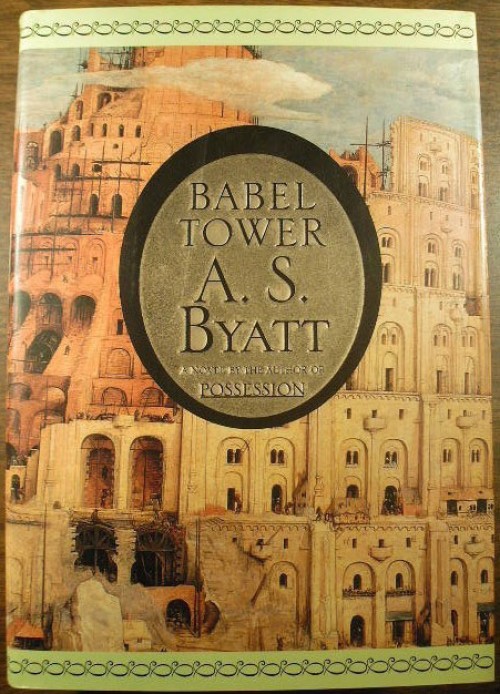
This isn’t my copy, because the cover (and several of the pages) were mauled by my dog awhile back. Again, I refuse to give it up, and still tote around my tattered tome. Like so:
Here’s a few good reviews of the quartet, if you’re curious – but honestly, go read them yourself! They are so beautifully realized. As a finished A Whistling Woman, (which I think is maybe my favorite of the four), I found myself constantly marveling over passages and feeling the intense urge to find and hug A.S. Byatt. She’s such a goddamn wonderful writer.
The Frederica Quartet – Frederica Potter/Alexander Wedderburn – all the beginning there was
Summer Reading: The Frederica Potter Quartet from Marissa Skudlarek
The Books: “Babel Tower” from The Sheila Variations

Vogue UK, May 1975 – via youthquakers
“At the end of the ride, when he comes to it, is a stile. Beyond the stile are rough fields and hedges. On the other side of the stile are a woman and child, standing quietly. The woman is wearing country clothes, jodhpurs, boots, a hacking jacket. She has a green headsquare knotted under her chin, in the style of Queen and her royal sister. She leans on the fence, without putting her weight on it, looking into the wood.”
— Babel Tower
I picture Frederica as looking like a cross between a young Grace Coddington and Tilda Swinton – gingery and sharp angles, with bright inquisitive eyes. Elegant, erudite and oddly elfin.
“There is a dress. It is dark charcoal grey with a high neck and long tight cuffs, woven with red silk braid and embroidery, very rich, very plain. It is a long tunic that goes over a short, slightly flaring skirt. It looks like, it is, Courrèges. Frederica, like most women with red hair, does not wear red, but there is one red, a clear dark vermilion, that brings out the fire in her hair and the gold in her dusting of freckles. This is that red. No one knows what to say.”
“Frederica comes back wearing the dress. In its honor she has put on black tights, and carefully dressed her hair in a chignon. She is beautiful. Frederica is never beautiful, though often alive with attractive energy, but just for the moment, in the Courreges dress, she is wholly beautiful. It is the word. The dress fits almost too perfectly: her small high breasts sit neat and elegant inside its beautiful seams; her thin wrists, her narrow waist, her long thin hips, are beautiful where the silk-lined cloth skims past them, making look like necessary forms in relation to each other. It is a strange style, formal, tailored, severe, ending so far above the knee that the brevity of the skirt should be childish, a gym-slip, a dolly-dress, but it is not.”
There’s a scene in Babel Tower where Frederica’s hair is somewhat brutally styled into a sleek Vidal Sassoon bob. I can’t help thinking that Byatt must’ve been modeling her haircut on Coddington’s. Frederica writes about herself in the third person:
“A woman is sitting in Vidal Sassoon’s salon, the Bond Street one. She is having her long hair, which she has always had, shorn into one of those smooth, swinging cuts, like blades in their precise edges and points. Two young men are working together on the nape of her neck. Her feet are surrounded by shanks and coils and wisps and tendrils of what until recently was her body. It sifts, it is soft, it pricks between her collar and her skin. One man leans over her and holds the two points of her new hair down, dragged down, to her jaw. He hurts her.”
— Babel Tower
Grace Coddington On Vidal Sassoon’s Famous Five-Point Haircut: ‘It gave you a certain freedom’
” Frederica goes to Paddington. She stands under the Departures and Arrivals. Her mouth is dry, her heart bangs audibly, her blood fizzes. She is alone. Her brown shoulder-bag hangs below the hem of her bright green cotton shift, which hugs her buttocks. Her long, thin legs tremble visibly. Her eyes are made up like does’ eyes. She has had her hair cut, finally: it is a shining bronze cap, or helmet, with pointed tongues licking her cheekbones.”
— Babel Tower
One of my favorite things about the quartet is that they contain books within books, stories within stories. There are letters, poems, a fantastic children’s fantasy, an Sadeian allegory, references to politics, events of the time, all the cultural shifts, and especially – the fashion. I love the way Byatt describes what Frederica wears, and even her makeup. It’s important.
Tilda Swinton Covers Candy Magazine
An aside: I restrained myself from buying this insanely expensive, insanely amazing magazine in New York, and I’m still regretting it. Oh, Tilda! Marry me.
CANDY 4. TILDA SWINTON from By Luis Venegas on
Vimeo.

Gayla Milovskaya by Barry Lategan, 1970s
“She wears a black linen shift, well above her knees, and a silk shawl, black, embroidered with creamy cabbagey roses and golden lilies, with a long, shimmering fringe. She has learned to line her eyes with a black, surprised stare, and to lengthen her lashes; nothing can make her angular quickness look doll-like, but this is as near as she will ever get. She has painted her wide mouth creamy brown, a pale colour, which does not wholly suit her.”
— Babel Tower

Photo by Barry Lategan for Vogue UK, June 1972.

Beauty Babe: Amber and Bronze
Ingrid Boulting by Barry Lategan For Vogue UK, January 1973.

Beauty Babe: Dreamy Summer Solstice
Editorial by Clive Arrowsmith for Vogue UK, April 1971.
So, of course I had to make an accompanying soundtrack to all this:
It’s a mix of new and old psychedelia and music from exotic otherwheres. It’s for putting on the record player while you eat dinner in front of the fire, or drink tea and stare out the window on a bitter cold day, dreaming of far-flung cities, warmer places. It is music for a red-haired woman named Frederica, for a woman made of flame, of white wood. A woman who dreams of traveling the world, but hasn’t quite yet.
For more on my obsession with perfumes for autumn weather: AUTUMNAL PERFUMES
Spirit Song Rock
by angeliska on November 20, 2012
Right. So, instead of getting married on 11.11.12 – I drove out to the hills, out to the place where the earth reaches up to touch the stars. The place where my bones come from, the place where my people are buried. This journey was big for me in so many ways. It was profoundly sad, as I had never intended to spend that day that way, alone on a hill – and it was also deeply healing, in ways I could never have predicted. I knew I had to go be in a place that welcomed me, that held me to it fiercely, my soul sewn to the dirt with copper threads. And I knew I had to do it by myself. This was my first solo roadtrip, my first solo highway drive, my first solo camping experience – and all on the heels of my first traffic ticket, and my first car accident. I was more than a little intimidated, but – I knew I had to make it happen, somehow, and I did, goddammit. I drove all the out there without incident, and as I neared my destination, I felt a kind of wild elation rising up in my chest.
There’s something incredibly powerful about making yourself do the things that scare you the most, and this year has been a long run of me facing and walking through many of my worst terrors. Being alone, being left, abandoned by the person I loved most. Losing his entire family, who I had thought of as my in-laws, who I had embraced as my own and been embraced by. Being lost. Fear of having been a fool, a chump, of wasting so much time investing love and energy in a dream that disintegrated so rapidly. Feeling cast aside, thrown away, in so many ways. Facing my grandfather’s death, losing him. Having painful separations from dear, old friends. Coming home to a dark and silent house. Driving. Driving. Driving. Every day, I have been walking through these fires that every day threaten to excoriate me, filet my heart out of my ribs and burn it into dust. I kneel before these tigers that will not let me be. I open my hands to them, and let my fears fall away.
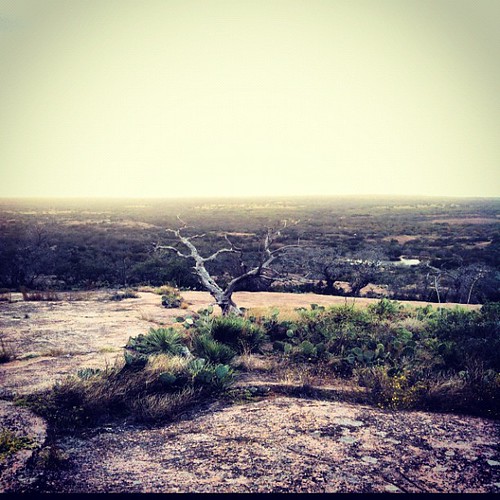
High point at the end of the world
In the midst of all this change and loss and growth, I have found that I am actually not so very alone. So many sweet friends and family have reached out to me with messages and words of encouragement and love that have helped me press onward. This letter from Henry James to a bereaved friend has been kindly passed my way a few times now, and I’ve been reading it again and again:
“Don’t melt too much into the universe, but be as solid and dense and fixed as you can. We all live together, and those of us who love and know, live so most. We help each other—even unconsciously, each in our own effort, we lighten the effort of others, we contribute to the sum of success, make it possible for others to live. Sorrow comes in great waves—no one can know that better than you—but it rolls over us, and though it may almost smother us it leaves us on the spot and we know that if it is strong we are stronger, inasmuch as it passes and we remain. It wears us, uses us, but we wear it and use it in return; and it is blind, whereas we after a manner see. My dear Grace, you are passing through a darkness in which I myself in my ignorance see nothing but that you have been made wretchedly ill by it; but it is only a darkness, it is not an end, or the end. Don’t think, don’t feel, any more than you can help, don’t conclude or decide—don’t do anything but wait.”
There’s a reason they call this place enchanted. It’s a sacred place, a place where the medicine men and women would go on vision quests, a place where you can hear the ancestors voices calling in the wind. Enchanted Rock was called “Spirit Song Rock” by native tribes, and was revered as a holy portal to other worlds. When you get up there, you can understand why. There’s something unearthly about the place, a humming in the stone, a deep vibration that resonates in your bloodstream. I like to come out here on New Year’s Day, to make that bracing climb in the bright air and breathe in the sense of possibility, of new beginnings. Lots of people come out and do the same, and there’s a feeling in the air – a giddiness, a sweetness. It’s very beautiful. They say foul fortune and death will befall anyone who climbs the rock with bad intent, that you must make the climb with an open heart. Seems to me that all the folks I’ve met up there on the spirit rock have very open hearts. It’s not a difficult trek, so all kinds of people make their way up – elders with walking sticks, little bitty children, young lovers, serious climbers, and groups of school-kids singing teenybopper pop songs in surprisingly gorgeous harmonies. Humans have been drawn to the magic of this place for a long time. It has a power, a pull.
“Enchanted Rock is an enormous pink granite pluton rock formation located in the Llano Uplift. The weathered dome, standing above the surrounding plain is known to geologists as a monadnock. The rock is actually the visible above-ground part of a segmented ridge, the surface expression of a large igneous batholith.
Archaeological evidence indicates human visitation at the rock going back at least 11,000 years.
Folklore of local Tonkawa, Apache and Comanche tribes ascribes magical and spiritual powers to the rock (hence the name ‘Enchanted Rock’). While attempting to hide from Anglo settlers in the area, the natives would hide on the top two tiers of the rock, where they were invisible from the ground below. The first European to visit the area was probably Álvar Núñez Cabeza de Vaca in 1536. The Tonkawa, who inhabited the area in the 16th century, believed that ghost fires flickered at the top of the dome. In particular they heard unexplained creaking and groaning, which geologists attribute to the rock’s night-time contraction after being heated by the sun during the day. The name “Enchanted Rock” derives from Spanish and Anglo-Texan interpretations of such legends and related folklore; the name “Crying Rock” has also been given to the formation.”
– from Wikipedia
“According to the Apache, the Giver of Life sent the Gan, or mountain spirits, to teach the people a better way to live, govern, hunt, and cure illness. Accordingly to the myth, these benevolent but powerful mountain spirits live forever in the mountain’s caves and can be appealed to for guidance and protection.
There is no question that Enchanted Rock was the site for both the Gan dance of the Apache and the vision quest of the Comanche and other Plains Indians. Some of the earliest European visitors mention seeing stone sepulchres on the summit. As recently as thirty years ago flint shards were found on a large flat area on the northwest summit.
In 1892, James R. Mooney wrote in The Ghost Dance Religion, about Wovoka, a famous Paiute prophet and medicine man, whose influence was felt throughout the Plains. Although the excerpt is not specifically about Enchanted Rock or its native inhabitants, on a deeper level it speaks directly to the spirit of the place, Plains Indian spiritual leaders, and the mythological foundation of their religion.
‘Wovoka was by nature of a solitary and contemplative disposition, one of those born to see visions and hear still voices…His native valley, from which he has never wandered was roofed over by a cloudless sky in whose blue infinitude the mind instinctively seeks to penetrate to far off worlds beyond. Away to the south the view is closed in by the sacred mountain of the Paiute, where their Father gave them the first fire and taught them their few simple arts before leaving for his home in the upper regions of the Sun-land… It seems set apart from the great world to be the home of a dreamer.'”
– from Enchanted Rock Texas
I’ve heard people say before that long drives give one time to think, to clear their brains out. My car had its shitty broken tape player ripped out years ago, so I have no distraction from the road. I’ve been singing more. Old songs, sad songs. I sing them loud, and sometimes off key, but my dogs don’t mind. They like it when I sing. Spirit songs, mournful ululations and rallying war-cries.
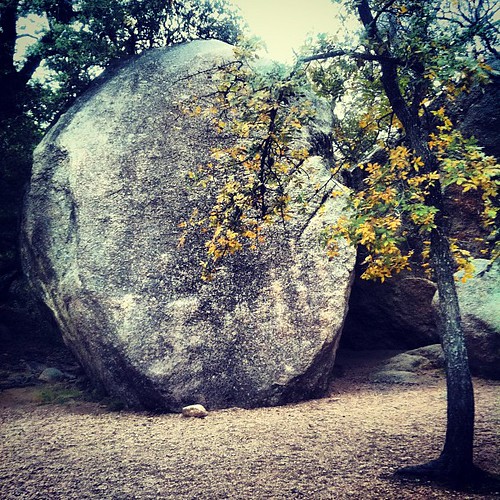
Giant rock orb, turning leaves. Texas autumn.
I want to always come back to this place.
I read this today, and am trying to embrace it:
To be fully alive, fully human, and completely awake is to be continually thrown out of the nest.
– Pema Chodron
I feel like that baby bird, tossed out of the nest. I’m being challenged, constantly to endure, to survive. More than that, though – I am finding a way to savor the sharp air in my lungs, the wind on my face, all these new experiences. The further you get from your comfort zone, the closer you get to the real magic of life. It’s turning out to really be true.

Home.
I belong to this earth, to this land. It’s strange to feel such a deep sense of belonging, of comfort in a place. I never imagined it would be here. I’ve traveled all over the world, and seen some of the most stunning landscapes, but few speak to me the way this land does. It is so ancient, so weathered, so magical. I always feel like a child here, humbled by the wonder of it.

Sentinels.
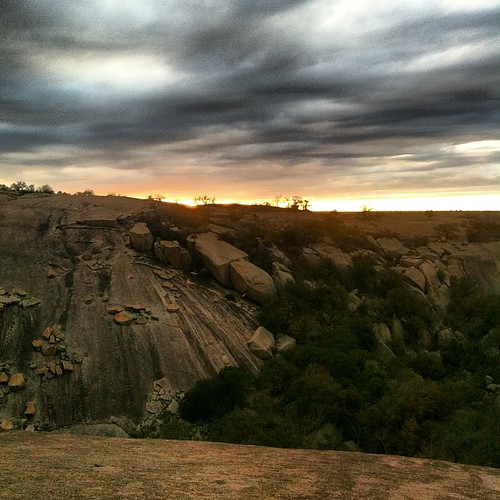
Stormy sunset at the end of time…
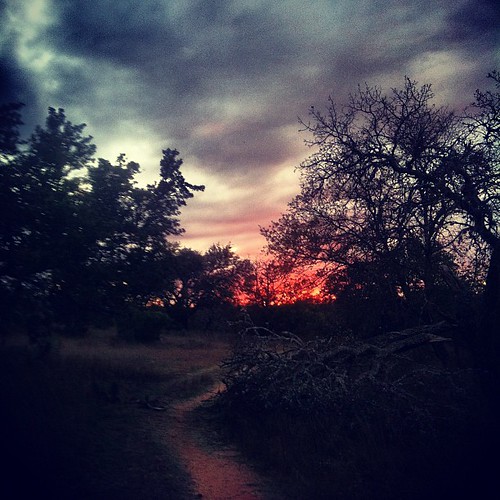
The fiery end of 11.11.11 out on a lonesome trail… The last I saw of it for quite a awhile. Damn elusive trail.
My trusty travel companion and I right before we lost the trail. I guess that’s what happens when you’re too busy taking pictures for you and your dog’s black metal album liner notes, right? Honestly though, I might likely be dead or worse if it weren’t for my bandmate and all around best friend, Prinzesse Grrizelda. She’s such an amazing creature.
Note to self for future adventures: when one has lost the trail, it is unwise to think that climbing up and over a mountain in the dark is a viable solution, or any kind of a clever shortcut. Because it totally isn’t. There’s this other rock next to Enchanted Rock called “Little Rock”. This is a misnomer. It is not really little at all, and also, I’m not sure there are any real trails that go down it. Maybe there are, and I just never found them, but man – I was up there trying to get down for a long time. I stubbornly kept trying to scale down sheer rock faces, dodging vicious patches of prickly pear, with only a tiny handheld flashlight. Thank god I had that, at least – I very nearly left the house without it. Lord, would I have been screwed. It was exhausting, and terrifying, and I would have stupidly kept at it, and probably fallen to my death or seriously injured myself if my wonderful canine companion hadn’t been so much wiser than me. She followed me down the rock up to a point, but when the cliff drops started getting really gnarly, she dug her heels in and wouldn’t jump down, no matter how hard I pleaded and tugged on her collar. I tried and tried to get her to come with me, but she wouldn’t budge. Because she’s way smarter than me! I finally had to give up my foolhardy descent and figure out a different plan.
The sun had dropped over the horizon rapidly, and I remembered a fellow hiker earlier making his way down the big rock asking me incredulously if I planned to be up there after dark. “Maybe!” I replied, feeling way too smug and cocky about my trailblazing skills. In reality, I usually have a pretty great sense of direction, and often enjoy the challenge of getting a bit turned around so that I can orient myself again. But that’s on solid ground, with lights and roads. There was a moment, sitting up on top of this huge rock with my little light and map that I realized I might have to either holler for help, or spend the night up on the hill. They say that anyone who spends the night on the hill becomes invisible. I think that means they get eaten by coyotes. My pride wouldn’t allow me to holler, though I certainly thought about it. Also, my little tent and warm bedroll were waiting for me back at camp, luring me back… When I made it back up and over the other side and found the little sandy wash I’d been following that was totally not a trail at all, I was ecstatic. I’d never been so thrilled to be back down on terra firma. I had to retrace my steps in the dark, with branches and brambles and cactus clawing at my hair and clothes, but I just put my head down and let Grrizzle lead the way.
After a bit, we lost the sandy wash path again, and she started to drag me off in a different direction, which I resisted vocally until – lo and behold, the goddamn trail! I nearly lay down and kissed it. How wonderful are wise dogs, and trails, and campfires and unbroken limbs? Oh, so very. Another two mile trek, on which we actually lost the trail twice more, and eventually we made it back to camp, where I ate apple pie for dinner and felt very grateful to be safe and alive. A word to the wise: don’t be a cocky butt-head like me when it comes to your safety out in wild places – the truth I realized when stuck up there on that mighty batholith was that no one was coming to save me. I was well and truly on my own, and my survival was completely up to me. One mis-step, one slipped handhold, and I could have ended up crumpled in a crevice, a jumble of gnawed bones.
Worst of all, everyone would have imagined it was intentional, I’m sure. How tragic! The heartbroken bride leaped to her death on her wedding day, doomed to join the ghosts of other wronged women who haunt the rock. Apparently, there are many. I wasn’t willing to join them, even by accident. My life, though it is often difficult and heart-wrenching, is incredibly precious to me. I intend to die only when I am an old, old woman. Alone on the hill, I looked up at the Milky Way and forced myself to breathe deeply, to trust in myself to get myself safely back to camp. The stars that night were brilliant, so bright they made me want to squint. I thought about how incredibly far away they are, how tiny I am in comparison. A speck of dust in the eye of god. Less than that. Thinking of that oughtn’t really be comforting to me, but it is. I lay awake later, huddled in my sleeping bag, and let myself be lulled to sleep by the mating calls of two great horned owls, and a pack of coyotes yipping madly. Feral cats yowled and hissed among the rocks, and at one point, a canine of some kind came up to the tent and growled for a long time, but by that point I was too tired to care.
I have a habit of refusing to give up the ghost. Ladies and gentlemen, this is what happens when a hurricane eats all your shoes and you only wear one pair of boots for a year or so. These trusty vintage Luccheses were gifted to me after Katrina, in mint condition, but I done wore ’em out. Wear and tear, rips and holes. We got plenty of character now, my boots and I.
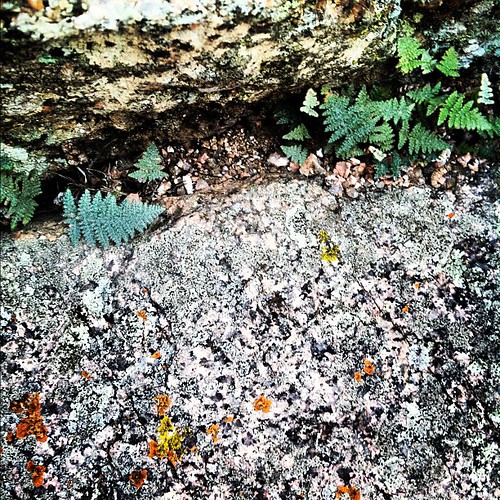
Tiny delicate ferns, little lichens. So many tiny magical things living on this juggernaut. Minutiae hidden in the crannies.
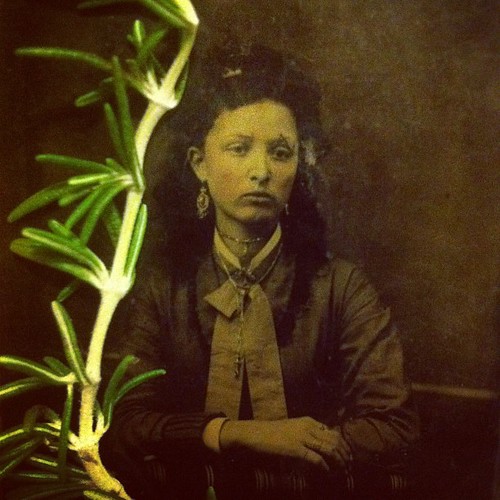
A tintype of an unknown ancestor of mine. Rosemary for remembrance.
I think she’s so stunning, and I love all her jewelry.
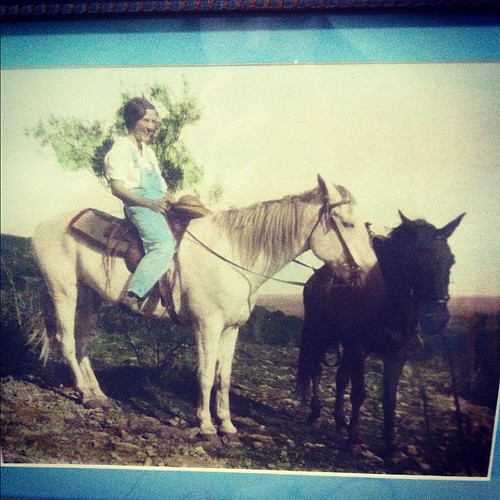
I come from a long line of cowgirls. This is my great-aunt Ruth. She and my grandmother used to ride horses to teach in small rural Texas schoolhouses. I have a lock of her hair in a bottle my aunt Ruth (her namesake) gave me on this trip.

My mama playing her guitar in a graveyard.
The last night of my journey, I slept on a cot in the room where my mother died, in the house where my great-grandmother and my grandparents lived. Family place, ancestral home. The tap-roots burrow deep to find the water under the rocky soil here. Generations of my family have been dwelling on this land for centuries. I hear them, I honor them, I return to them.
I made this mix to listen to out there, but the wondrous still quietness and the animal chorus proved too captivating. I left it until I came back to civilization. COLD & STARRY EYED – Music for cosmic dreamers wandering around lost on high hills in the cold dark night. Shivering and dazzled, eyes raised to the sky.
The Fool On The Hill was my favorite song when I was little – I used to play it over and over and spin around and dance in the living room. I love that it’s so happy and sad all at once. I don’t mind being a fool on a hill, sometimes.
But the fool on the hill,
Sees the sun going down,
And the eyes in his head,
See the world spinning ’round.
11.11.12. – INSTEAD
by angeliska on November 11, 2012
11.11.11 – ELEVEN ELEVEN ELEVEN – A WISH.
One year ago, today, we went to Marfa instead of getting married. My love and I. We went out there, to the big sky and dry desert to try to heal, to connect, to repair our bond. We had an amazing time, a beautiful journey. I thought that something about being under those bright stars, huddling together out in the cold wind, seeing so much beauty, exploring it all – I believed it was a magical spell that would bind us closer. I had so much hope for us, then. Despite everything that was going so wrong, I honestly never, not even for an instant, imagined that a year from now we’d be split apart. We had been together for seven years. Seven years that went by so swiftly, so (for the most part) very sweetly. All over now in a flash – poof! It still seems like a bad dream, an alternate reality from the twilight zone – a possibility that I’d never even really considered: that we would not survive this intact, that we would not be spending the rest of our lives together, happily ever after. Contemplating this current bizarro-world reality is like looking at my life through a broken funhouse mirror – skewed and strange and seemingly impossible. I’ve been waiting for the day when I can fully accept it, fully understand that the person I pledged my heart, my life and my future to has walked away from me, from all that I held in my open arms. That he chose something else.
I made a wish, a true wish, with my whole heart.
It was not granted.
We, who were supposed to be joined so completely on this day, are sundered, separate, alone. How could this be? My mind still doesn’t have the ability to comprehend it. What is this – this loss? Empty spaces echoing out where something used to be: a warm hand, the most familiar face, a body stretched out warm beside me all night long. What is this emptiness? I walk around all day, going through the motions, choking on that void, that hollowness that builds up in my chest until I feel as though I might crumple in on myself, fall apart. I don’t have answers. I don’t have much – a sinewy shred of survival instinct that keeps my head up, keeps me walking. I have love, still – for myself, for my good friends and family, for my animals, my plants. Oh, and I have memories. Memories that seem fresh as yesterday, memories that stop me in my tracks and make me want to fall to my knees: the way he used to look at me – so in love. I miss that. I miss it all, so much. I have these little snippets, a handful of cast-off snapshots from a vacation that was meant to be a happy recollection one day – we’d tell stories when we were old about how we went there and were saved, how we remembered how much we loved each other, how we found in each other the best company, the eternal companion.
But that’s not what happened, in the end.
Like Sugar says, “Acceptance is a small, quiet room.” I visit this room every day, several times a day. I repeat those words to myself like a mantra when my brain boggles, when my mind feels like it will break, trying to understand what the hell happened to my life, to our love. I go to that empty room and I sit with it, this thing that has happened. Sugar says, “Acceptance asks only that you embrace what’s true.” Not that you like it, or want it, or ever wished for it – but that you sit with it, stare at it directly, acknowledge that it exists. This has been very difficult for me. I read the words I wrote one year ago, today. I look at the pictures of us, and I just can’t fit it all together. It’s like a puzzle with too many pieces gone missing. It doesn’t make a picture anymore. I meant every word I wrote, I meant them with everything in me, everything that is me. How could that wish not be granted? Every time my mind goes, “What!? How…? Why?” I have to lead it by the hand back to that small, quiet room. My mind and I, we have to sit in time-out a lot, sitting with this ugly thing, this huge sense of loss. Somedays, I feel like an Alzheimer’s patient who has to be reminded every day that their spouse is gone, is not there with them anymore. My hands reach for him in our bed in the mornings before I’m completely awake. I still save articles that I think he would enjoy reading. I have to stop myself from buying him presents when I see something I know he would like. We’re not there yet – we’re really not anywhere. I have no idea how to enter that particular transition. It’s not something I ever wanted, or imagined I would have to do – to disconnect myself from someone who had become part of my heart. It seems so unnatural – an alien concept, a shard embedded deep in my palm. It’s one I cannot seem to unclutch. I am trying, though – to let it go. It is so, so hard. I don’t know how to do this.
Maybe it’s not necessary to know right now. I have to trust that the knowing, the understanding might come later. Maybe it’s only necessary, for the moment, to endure it. A very dear, very wise friend of mine told me something else I try to remember on a daily basis, from a text she sent me in the middle of the night, in one of my more desperately unhappy moments – she wrote:
“Keep your head down. This is not the time for analysis or big picture thinking. This is the part where you eat good food, exercise, read, watch movies, hug your pets, buy a new dress, cut your hair, put hours and days behind you and before you know it, you get stronger and far enough from ground zero to see the big picture. But for now, you’re in the thick of it, so keep your head down. Time is your best friend – but most definitely not your only one.”
I can’t tell you how many times I’ve lain awake in the dark, scrolling back through my texts to find that one and reread it, remember it. It’s among some of the best advice I’ve been given, and I’ve been trying to follow it to the letter.
In the meantime, I mend holes in my clothes, I glue together broken teacups, I fix wonky table legs – as if these small repairs could somehow symbolically add it, to help me heal the broken parts of me. I walk around most days feeling like one of those gory cartoons where the cat has a giant shotgun-blasted hole through their torso that everyone can see through. When people ask me how I am, I get confused, because I forget that they can’t see it. I’ve come to really hate answering that question, even though I know it’s always well-meant. I want to answer honestly, and then I don’t want to. Don’t want to lay my tragedy on anyone. I usually go for something noncommittal like, “I’m happy to be here!” or, “I’m happy to see you!” Those things are true, and speak to what’s happening in that exact moment. Right? Ugh.
Recently, I discovered that though some reprehensible technological loop-hole, I’d (hopefully only temporarily?) lost years and years worth of photographs from my archives. So, so many years worth of memories. Gone, just like that. I’m praying for a solution/miracle that might allow me to recover them soon, but right now, they are out there floating in nothingness. All the photos I took on our trip to Marfa, our pre-emptive honeymoon for a wedding that never happened – all vanished. Like it never happened. Another hole, a lacuna – a space where we were, and now, are not. All I have to show we were ever there are these pithy instagrams, cheery snapshots that don’t really tell a story. We went here, we saw this, it was pretty, it was funny, we laughed. We held hands. We wandered down empty streets in ghost towns at sunset, drinking scotch out of fine cut-glass tumblers, like real outlaws. We drove on rough dirt roads in the black of night into the mountains in search of hot springs. We nearly set fire to our hotel room. We held each other. We whispered secrets. We missed our train because we were hunting for rocks. We enjoyed each other completely. Each day and night we spent in West Texas was truly a magical adventure, and I will always treasure the time we spent there. Maybe next year, I’ll be able to tell these stories. Right now, they’re lost to me, in so many ways.
Here are some of the things we saw:
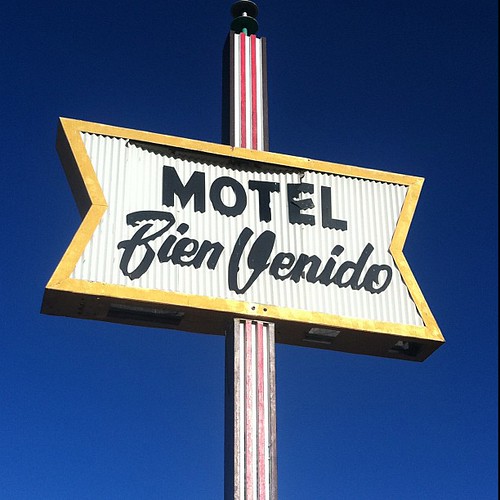



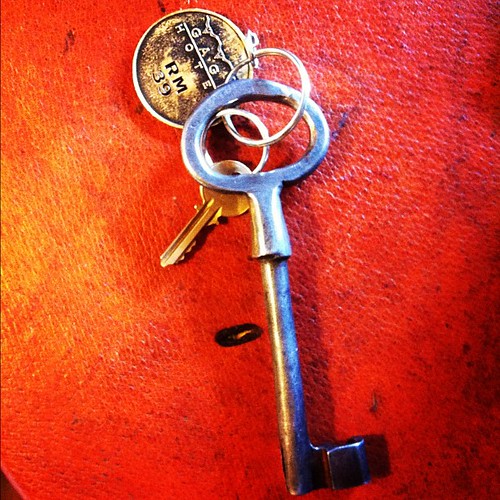

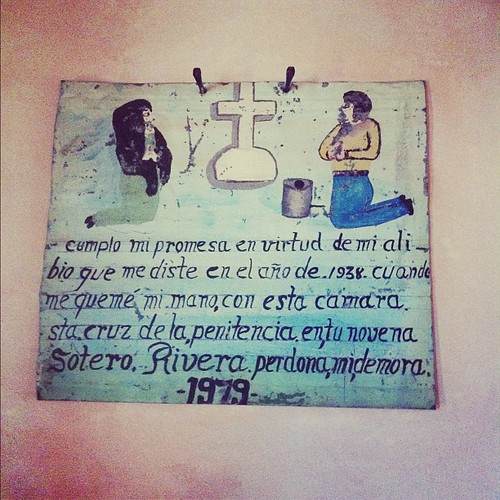
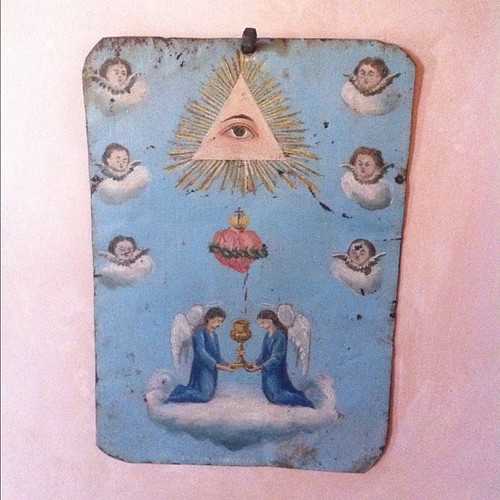
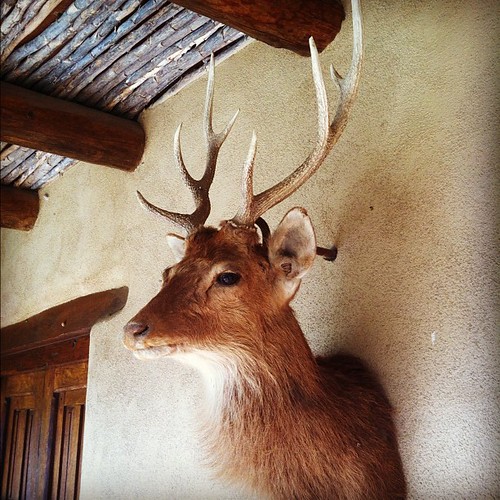


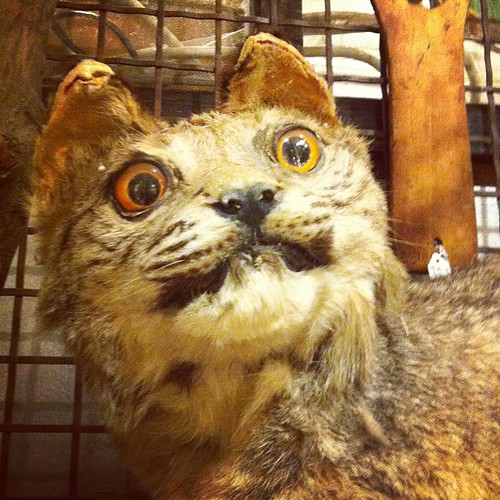


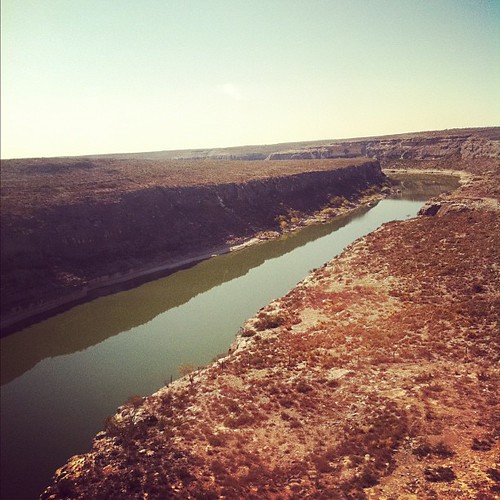
I’ll spend this year’s 11.11 high up on a hill, alone. Instead. Instead of walking down an aisle in a white dress with tears of joy streaming down my face as I prepare to marry the man I love. This year, too, there is no magical cave filled with all the people we love and cherish most gathered around us. There is no majestic valley where we will dance and celebrate into the night. Those things live in a box, a hope chest filled with cobwebs and dust collecting on a veil and wax orange blossoms slowly disintegrating. Instead, there is this howling sound. Instead, here is me and my heart. Still here, still beating, but not joined. Instead, I came out to the place where I come from, the land that has always welcomed me as its child, despite being harsh and forbidding for most but the hardiest of creatures. My plan is to camp by myself out at Enchanted Rock – to do healing rituals for myself, to listen to the wind blow, to embrace this newfound solitude I never asked for or desired. Despite my resistance, I have found that there are aspects of it that I have come to treasure. This past year has been repeatedly forcing me to face all my worst fears head-on, and one by one, I have been meeting them on the road. They leer and jabber and spit at me and I walk through them, dissolve them, pierce and pin them with sharp swords. I sit with them, too.
Offer tea. Breathe deep. Let them go.
O DEATH
by angeliska on November 2, 2012
I am so grateful to be experiencing Day of the Dead in New Orleans again this year – to be able to engage in the ritual of the yearly procession to honor our beloved dead, and to remind ourselves that life is fleeting, and precious. My altar sits at home, sadly in need of dusting and tending – there’s been so much death and loss this year, that at a certain point, I find myself abandoning my rituals when I need them most. Grief becomes suffocating, all-consuming, and I forget that I’ve found ways to walk through it, remembered the old ways – traditions that once were in place for ages, now lost to many. I’ve had a lot of death in my life, ever since I was a little child. I’ve lost so many friends and relatives – to disease, suicide, murder, accidents – so many untimely ends to the brightest stars, harshly snuffed out. I’ve been left standing, so many times, staring at the sky, looking for lights that used to be there. At a certain point, I realized that in this life, a big part of the work I hope to be able to do will deal with death: with helping people process it, with the rituals of burial and mourning, and of grieving. I feel I must eventually do this work, somehow – for myself, and hopefully, to help others. I hate living in a society where the process of dying and mourning has been whitewashed, sanitized, made safe and tidy. The modern business of death, is just that: a business – and it is intended to be bland, brief and entirely devoid of soul. At least most “traditional” funerals I’ve been to have felt like that, anyway. Once the funeral is done and the corpse is buried, everyone is expected to put on a brave face and send out sympathy cards or maybe a casserole and that’s the end of it. We don’t dress in mourning: wearing black or ripping your clothing signifies nothing at all anymore. We have no real way to publicly show that we are grieving – and really, no one wants to know. Sometimes I meet people who tell me that they’ve never really lost anyone close to them. There are moments when I think of them as lucky, and moments when I pity them – eventually, they will experience what it is to have someone they loved, someone very close to them, evenutually die, and they won’t have any idea what to do when that happens. We are so woefully unequipped, as a society, to be able to process death in healthy ways, and I would like to try, in whatever ways I can, to help change that. I’m not sure completely yet how this work will take shape, but I know that writing about it is a part of that, talking about it, and being there for those I care about who are going through it. I’m also learning more about green burials and home funerals, and I will be writing more on this subject soon, and sharing some of what I’ve discovered, very soon.
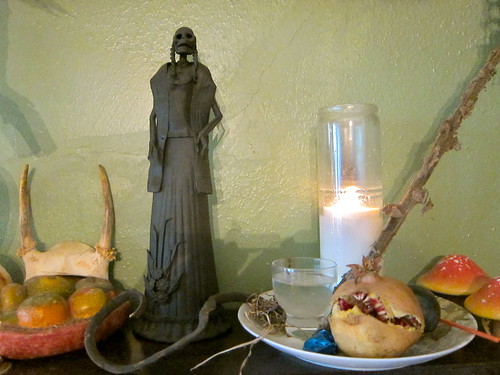
My little altar for the dead at home.
They say death is hardest for those who are left behind, and I agree with that for the most part – but I want to share a piece of writing that has stayed with me for a year, by Sara Douglass, a writer of science fiction who died of cancer this year. From what I’ve seen, the process of dying, for those who know it’s coming, it’s not easy or gentle. It’s terrifying, and it’s really fucking lonely. I have several friends who work in hospices, and in my mind, they are the bravest, kindest people – to willingly go into that darkness, to hold the hands and smooth the brows of this who are facing their final journey into whatever lays beyond the veil. I hope you will take some time to read what she wrote. It’s important. Eventually someone you love will die. Eventually, we all will. There’s no hiding from it, no pretending it won’t happen – or that when it does it will be graceful. If anyone you love is ever sick and dying, don’t shy away from them. Don’t be too busy to go see them, to spend time with them before they go. Don’t be afraid to touch them, or drown them in well-meaning but ultimately empty platitudes. They don’t always need to to say the right thing, or to bring flowers – but they do need to see you, they need not to be left alone, abandoned. I say this as much to myself as to anyone else. I think of how swiftly we can wink out of existence, how fleeting all this world is, and I feel a panic – to clutch every single person I have ever loved, close, close, to tell them how much I adore and appreciate them. You can never say it enough, never show it enough – and there will never, ever be enough time.
Originally from blog “Notes from Nonsuch”
The Silence of the Dying
By Sara Douglass
Many years ago I did an hour long interview on Adelaide radio (with Jeremy Cordeaux, I think, but my memory may be wrong). The interview was supposed to promote one of my recent publications, but for some reason we quickly strayed onto the subject of death and dying, and there we stayed for the entire hour. I proposed that as a society we have lost all ability to die well. Unlike pre-industrial western society, modern western society is ill at ease with death, we are not taught how to die, and very few people are comfortable around death or the dying. There is a great silence about the subject, and a great silence imposed on the dying. During the programme a Catholic priest called in to agree with the premise (the first and last time a Catholic priest and I have ever agreed on anything) that modern society cannot deal with death. We just have no idea. We are terrified of it. We ignore it and we ignore the dying.
Today I’d like to take that conversation a little further, discuss modern discomfort with death, and discuss the silence that modern western society imposes on the dying. Recently I’ve had it hammered home on a couple of occasions how much the dying are supposed to keep silent, that ‘dying well’ in today’s society means keeping your mouth firmly closed and, preferably, behind closed doors.
Never shall a complaint pass your lips. How many times have we all heard that praise sung of the dying and recently departed, “They never complained”?
Death in pre-industrial society was a raucous and social event. There was much hair-tearing, shrieking and breast beating, and that was just among the onlookers. Who can forget the peripatetic late-medieval Margery Kempe who shrieked and wailed so exuberantly she was in demand at all the death beds she happened across? Suffering, if not quite celebrated, was at least something to which everyone could relate, and with which everyone was at ease. People were comfortable with death and with the dying. Death was not shunted away out of sight. Grief was not subdued. Emotions were not repressed. If someone was in pain or feeling a bit grim or was frightened, they were allowed to express those feelings. Unless they died suddenly, most people died amid familiar company and in their own homes amid familiar surroundings. Children were trained in the art and craft of dying well from an early age (by being present at community death beds). Death and dying was familiar, and its journey’s milestones well marked and recognizable. People prepared from an early age to die, they were always prepared, for none knew when death would strike.
Not any more. Now we ignore death. We shunt it away. Children are protected from it (and adults wish they could be protected from it). The dying are often not allowed to express what they are really feeling, but are expected (by many pressures) to be positive, bright and cheerful as ‘this will make them feel better’ (actually, it doesn’t make the dying feel better at all, it just makes them feel worse, but it does make their dying more bearable for those who have to be with them).
When it comes to death and dying, we impose a dreadful silence on the dying lest they discomfort the living too greatly.
I have done no study as to when the change took place, but it must have been about or just before the Industrial Revolution — perhaps with the mass movement into the cities and the subsequent destruction of traditional communities and community ties, perhaps with the rise of the modern medical profession who demanded to control every aspect of illness, perhaps with the loosening grip of religion on people’s lives during the Enlightenment.
Certainly by the nineteenth century silence and restraint had overtaken the dying. The Victorian ideal was of the dying suffering sweetly and stoically and silently (we’ve all read the novels, we’ve all seen the paintings). Those who didn’t die sweetly and stoically and silently but who bayed their distress to the moon generally ended badly by dropping their candle on their flammable nightgown, and then expiring nastily in the subsequent conflagration which took out the east tower of whatever gothic mansion they inhabited. The lingering commotion and the smouldering ruins always disturbed everyone’s breakfast the next morning. There was much tsk tsk tsk-ing over the marmalade.
By the mid-nineteenth century, if not earlier, the lesson was clearly implanted in our society’s collective subconscious.
Death should be silent. Confined. Stoic.
Sweet, stoic and silent was the way to go. (Again I remind you that a sweet, stoic and silent death is still praised innumerable times in today’s society; by the time we have reached early adulthood we have all heard it many, many times over.) The one exception is the terminally ill child. Terminally ill children are uncritizable saints. The terminally ill adult is simply tedious (particularly if they try to express their fears).
All this silence and stoicism scares the hell out of me.
In that radio interview many years ago I spoke as a historian. Today I speak as one among the dying. Two years ago I was diagnosed with cancer. Six months ago it came back. It is going to kill me at some stage. Now everyone wants a date, an expected life span, an answer to the ‘how long have you got?’ question. I don’t know. I’m sorry to be inconvenient. I am not in danger of imminent demise, but I will not live very long. So now I discuss this entire ‘how we treat the dying’with uncomfortable personal experience.
Now, with death lurking somewhere in the house, I have begun to notice death all about me. I resent every celebrity who ‘has lost their long battle with cancer’. Oh God, what a cliché. Can no one think of anything better? It isn’t anything so noble as a ‘battle’ gallantly lost, I am afraid. It is just a brutal, frustrating, grinding, painful, demoralizing, terrifying deterioration that is generally accomplished amid great isolation.
Let me discuss chronic illness for a moment. As a society we don’t tolerate it very well. Our collective attention span for someone who is ill lasts about two weeks. After that they’re on their own. From my own experience and talking to others with bad cancer or chronic illness, I’ve noticed a terrible trend. After a while, and only a relatively short while, people grow bored with you not getting any better and just drift off. Phone calls stop. Visits stop. Emails stop. People drop you off their Facebook news feed. Eyes glaze when you say you are still not feeling well. Who needs perpetual bad news?
This is an all too often common experience. I described once it to a psychologist, thinking myself very witty, as having all the lights in the house turned off one by one until you were in one dark room all alone; she said everyone described it like that. People withdraw, emotionally and physically. You suddenly find a great and cold space about you where once there was support. For me there has been a single person who has made the effort to keep in daily contact with me, to see how I am, how I am feeling, and listen uncomplainingly to my whining. She has been my lifeline. She also suffers from terrible cancer and its aftermath, and has endured the same distancing of her friends.
The end result is, of course, that the sick simply stop telling people how bad they feel. They repress all their physical and emotional pain, because they’ve got the message loud and clear.
People also don’t know how to help the sick and dying. I remember a year or so ago, on a popular Australian forum, there was a huge thread generated on how to help a member who was undergoing massive and life-changing surgery that would incapacitate her for months. People asked what they could do. I suggested that if one among them, or many taking it in turns, could promise this woman two hours of their time every week or fortnight for the next few months then that would help tremendously. In this two hours they could clean, run errands, hang out the washing, whatever. And they had to do all this while not once complaining about how busy their own lives were, or how bad their back was, or how many problems they had to cope with in life. Just two hours a fortnight, with no emotional-guilt strings attached. Whatever she wanted or needed. Freely given. Bliss for the incapacitated or chronically ill.
But that was too difficult. Instead the poor woman was buried under a mountain of soft toys, dressing gowns, bath salts and bombs, daintily embroidered hankies, a forest’s worth of Hallmark cards, chocolates and flowers and exhortations that everyone was ‘thinking of her’. None of which helped her in any way, of course, but all of which assuaged the guilt of the gift-givers who mostly promptly forgot her and her daily horrific struggle through life. Modern attention spans for the chronically ill are horribly short, probably because chronic or terminal illness in today’s society is horribly tedious. Tedious, because we are all so uncomfortable with it.
Instead, too often, it is up to the sick and the dying to comfort the well and the un-dying.
Just take a moment to think about this, take a moment to see if you have ever experienced it yourself. The dying — sweet, stoic, silent — comforting those who are to be left behind. I know I experienced it when first I was diagnosed with cancer. I found myself in the completely unreal situation of having, over and over, to comfort people when I told them I had cancer. In the end I just stopped telling people, because almost invariably I was placed into the bizarre situation of comforting the well by saying everything would be all right (which, of course, it won’t, but that’s what people needed to hear to make them comfortable about me again).
The dying have been indoctrinated from a very young age into this sweet, stoic and silent state. They earn praise for always being ‘positive’ and ‘bright’ and ‘never complaining’. Perhaps they are bright and positive and uncomplaining, but I am certain they lay in their beds with their fear and anger and grief and pain and frustration completely repressed while modern expectation forces them, the dying, to comfort the living.
I am sick of this tawdry game. I am sick to death of comforting people when all I want is to be comforted. I am sick of being abandoned by people for months on end only to be told eventually that ‘I knew they were thinking of me, right?’ I am sick of being exhorted to be silent and sweet and stoic. I know I face a long and lonely death and no, I don’t think I should just accept that.
I don’t think I should keep silent about it.
I have witnessed many people die. As a child I watched my mother die a terrible death from the same cancer that is going to kill me. As a registered nurse for seventeen years I have seen scores of people die. I have watched the dying keep cheerful and reassuring while their family were there (forced by modern expectation of how people should die), only to break down and scream their terror when the family have gone. The one thing they all said, desperately, was “Don’t let me die alone.” But mostly they did die alone, doors closed on them by staff who were too frantically busy to sit with them, and relatives who have gone home and not thought to sit with their parent or sibling. People do die alone, and often not even with the slight comfort of a stranger nurse holding their hand. If you put your relative into a hospital or a hospice or a nursing home, then their chances of dying alone and uncomforted increase tremendously. I want to die at home, but I am realistic enough to know that my chances of that are almost nil as impersonal ‘carers’ force me into a system that will remove me from any comfort I might have gained by dying in familiar, loved and comforting surroundings.
My mother, who died of the same cancer which will kill me, kept mostly stoic through three years of tremendous suffering. But I do remember one time, close to her death, when my father and I went to visit her in hospital. She was close to breaking point that evening. She wept, she complained, she expressed her fears in vivid, terrifying words. I recall how uncomfortable I was, and how relieved I was when she dried her tears and once more became cheerful and comforting herself. I was twelve at the time, and maybe I should feel no guilt about it, but I do now, for I know all too well how she felt, and how much she needed comforting far more than me.
She died in her cold impersonal hospital room in the early hours of the morning, likely not even with the comfort of a stranger nurse with her, certainly with none of her family there.
The great irony is that now I face the same death, from the same cancer.
That is the death that awaits many of us, me likely a little sooner than you, but in the great scheme of things that’s neither here nor there. Not everyone dies alone, but many do.
Not everyone suffers alone, but most do it to some extent.
It is the way we have set up the modern art of death.
I am tired of the discomfort that surrounds the chronically and terminally ill. I am tired of the abandonment. I am tired of having to lie to people about how I am feeling just so I keep them around. I am tired of having to feel a failure when I need to confess to the doctor or nurse that the pain is too great and I need something stronger.
I am tired of being made to feel guilty when I want to express my fear and anguish and grief.
I am tired of keeping silent.
******************
Thank you for reading this far, and being my companion this far. I promise to be more stoic in future. But just for one day I needed to break that silence.
May 22nd, 2010
Sara Douglass was born June 2, 1957. She died on September 27, 2011.
Here are some of my favorite old songs about death. I especially love this first one:
Shirley & Dolly Collins – Death & The Lady
Oh Death – Dock Boggs
Ralph Stanley – Oh Death
On Death, without Exaggeration
It can’t take a joke,
find a star, make a bridge.
It knows nothing about weaving, mining, farming,
building ships, or baking cakes.
In our planning for tomorrow,
it has the final word,
which is always beside the point.
It can’t even get the things done
that are part of its trade:
dig a grave,
make a coffin,
clean up after itself.
Preoccupied with killing,
it does the job awkwardly,
without system or skill.
As though each of us were its first kill.
Oh, it has its triumphs,
but look at its countless defeats,
missed blows,
and repeat attempts!
Sometimes it isn’t strong enough
to swat a fly from the air.
Many are the caterpillars
that have outcrawled it.
All those bulbs, pods,
tentacles, fins, tracheae,
nuptial plumage, and winter fur
show that it has fallen behind
with its halfhearted work.
Ill will won’t help
and even our lending a hand with wars and coups d’etat
is so far not enough.
Hearts beat inside eggs.
Babies’ skeletons grow.
Seeds, hard at work, sprout their first tiny pair of leaves
and sometimes even tall trees fall away.
Whoever claims that it’s omnipotent
is himself living proof
that it’s not.
There’s no life
that couldn’t be immortal
if only for a moment.
Death
always arrives by that very moment too late.
In vain it tugs at the knob
of the invisible door.
As far as you’ve come
can’t be undone.
– Wislawa Szymborska
3 different interpretations of the hymn “Idumea” (written by Charles Wesley, 1793), from the album “Black ships ate the sky” – Current 93:
1) Clodagh Simonds
2) Bonnie Prince Billy (Will Oldham)
3) Shirley Collins
And am I born to die?
To lay this body down?
And as my trembling spirits fly
Into a world unknown
A land of deeper shade
Unpierced by human thought
The dreary region of the dead
Where all things are forgot
Soon as from earth I go
What will become of me?
Eternal happiness or woe
Must then my fortune be
Waked by the trumpet’s sound
I from my grave shall rise
And see the Judge with glory crowned
And see the flaming skies
Patrick Wolf – Idumea
Current 93 feat. Antony Hagerty – Idumea
Idumea / Current 93 & Marc Almond
Skin and Bones
Good Bye, Son – from Letters of Note
Holbein’s Dance of Death
Strawberige: Theme: Mourning
Further reading from November 2nds of yore:
✂ LAS CATRINAS
✂ Day of the Dead in New Orleans
✂ Cempasúchil por los Muertos
✂ Día de los Muertos – R.I.P. Studs Terkel
✂ Santissima Muerte!
LITTLE BLACK APPLES FROM HURRICANE STREET
by angeliska on October 31, 2012
Witch witch, where do you fly?
Under the clouds and over the sky.
Witch, witch, what do you eat?
Little black apples from Hurricane Street.
Witch, witch, what do you drink?
Vinegar and good red ink.
Witch, witch, where do you sleep?
Up in the clouds where the pillows are cheap.
It’s been surreal and magical to be back in the warm embrace of New Orleans – and especially strange to have everything feel so calm and peaceful here (despite the full moon, Halloween holiday, and all associated deviltry) when up north, New York has been so recently beleaguered by a hurricane. Everything feels sort of backwards, and this time, I’m very grateful to be on the tranquil side of things, though a deep sense of foreboding about the frequency and intensity of future storms makes me very concerned for everyone I know (and those I don’t) who live along the coasts. We haven’t seen the end of this shit, and it seems like it might be too late to turn back.
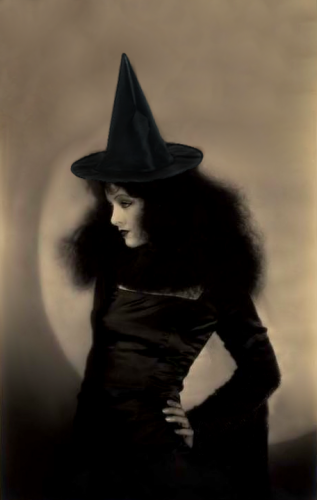
☾ Publishers destroy Scary Stories to Tell in the Dark’s amazing artwork – I know this has been going around for awhile, but I always think of these stories at this time of year. The illustrations were what made even some of the less scary stories truly terrifying. It boggles the mind to think that anyone would ever dream of even trying to touch that. Last night, we celebrated the Mudlark Public Theatre’s 4th anniversary with their annual Halloween Cabaret Grotesque. The Mudlark Puppeteers performed a chilling rendition of one of my favorite stories from the collection, The Sinner Drum. It was terrifying and beautiful, as you might imagine!
☾ Wikipedia Entries to Read in the Dark
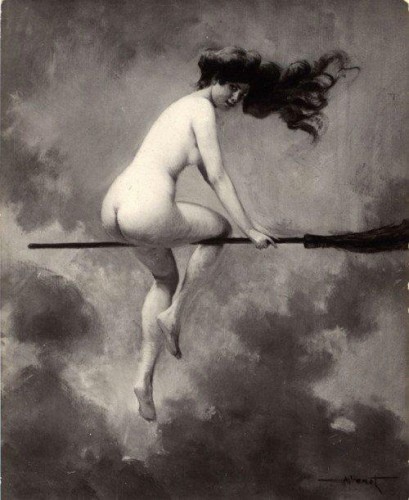
☾ A beautiful full moon post from artist Kelly Louise Judd: Hunter’s Moon
☾ Inside the lost island of New York: Eerie pictures of the abandoned leper colony just 350 yards from the Bronx
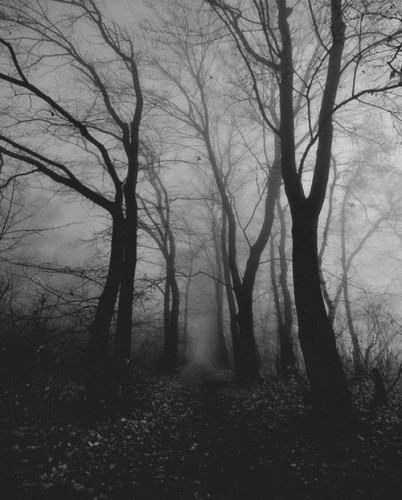
☾ The Vampire Beetle Bedpost Confessions
☾ A peek into Haunted Air – Anonymous Halloween photographs from c.1875–1955
“The photographs in Haunted Air provide an extraordinary glimpse into the traditions of this macabre festival from ages past, and form an important document of photographic history. These are the pictures of the dead: family portraits, mementos of the treasured, now unrecognizable, and others. The roots of Halloween lie in the ancient pre–Christian Celtic festival of Samhain, a feast to mark the death of the old year and the birth of the new. It was believed that on this night the veil separating the worlds of the living and the dead grew thin and ruptured, allowing spirits to pass through and walk unseen but not unheard amongst men. The advent of Christianity saw the pagan festival subsumed in All Souls’ Day, when across Europe the dead were mourned and venerated. Children and the poor, often masked or in outlandish costume, wandered the night begging “soul cakes” in exchange for prayers, and fires burned to keep malevolent phantoms at bay. From Europe, the haunted tradition would quickly take root and flourish in the fertile soil of the New World. Feeding hungrily on fresh lore, consuming half–remembered tales of its own shadowy origins and rituals, Halloween was reborn in America. The pumpkin supplanted the carved turnip; costumes grew ever stranger, and celebrants both rural and urban seized gleefully on the festival’s intoxicating, lawless spirit. For one wild night, the dead stared into the faces of the living, and the living, ghoulishly masked and clad in tattered backwoods baroque, stared back.”

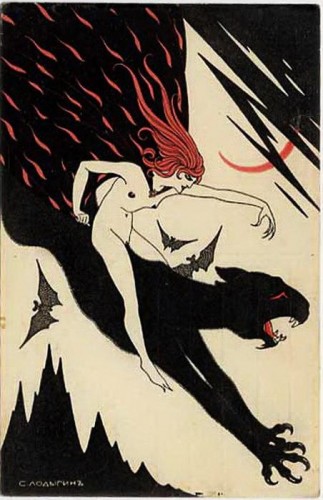
☾ Sabbat Wine, Flying Ointment & Enthogens
☾ Make your Own Sabbat Wine and Flying Ointment
Here’s an interesting selection of videos featuring flying brujas and mysterious levitation:

I made an 8tracks mix to listen to while I get dressed up! It’s dedicated to all my witchy sistren celebrating Samhain this season:
Magic from Halloweens of yore:
✪ I dressed as Vali Myers (one of my very favorite witches, ever) for Halloween last year…
✪ QUEENS OF HALLOWEEN
✪ New Orleans Hallowe’en
✪ Spookhouse Honey
✪ The Witches’ New Year
✪ Ha-ha-halloweenie
✪ ECTOPLASMIC HONEY
✪ WITCHNESS
WRITER – SOOTHSAYER – SILVERSMITH – WITCH
by angeliska on October 26, 2012
Words and images are the real tools of magic-making, stronger than wands or cups or candles. They hold a deep and ancient power to create or alter our realities. From shadows and handprints on the cave wall to whispered incantations, even with no altar or physical tools, a witch or shaman (or anyone, really) can effect powerful changes. This is why the way that you see yourself and present yourself to the world is so very important: even an everyday object like a business card can hold and transmit that power. I thought about this a lot when I realized it was time to buckle down and make real grown-up style business cards. For the past couple of years, I’ve been satisfied using moo cards – they fit nicely in the vintage cigarette case I like to carry, and I liked how each one was different, unique. But for all their individual uniqueness, they were also becoming very recognizable – I wasn’t the only person anymore with cute, little bitty moo cards, dammit! In a handful shaken out of my purse at the end of a night, there wasn’t much to distinguish my card from anyone else’s. Not that presenting your business card needs necessarily to resemble an arcane ritual out of American Psycho – especially considering how in this day and age, they are perhaps in danger of becoming somewhat unnecessary. And yet, there’s something nice and seamless about just handing someone your card – especially if you have a name that’s kind of difficult to spell or interpret in a noisy nightclub. I enjoy the ritual of it, the harkening back to Victorian calling cards or cartes de visite, left on a silver tray and presently by a butler (oh, if only…) I like the idea of someone coming across the little paper rectangle emblazoned with the images and words I have chosen to convey a sense of who I am, and maybe remembering our paths crossing, however briefly.
I believe that what you say or think about yourself, you bring into being, quite literally: meaning, you are the only one that has the power to invent yourself, or reinvent yourself. The image that you present to the world at large is who you are – or it can become so, all rooted in those deep, initial perceptions. When someone says, “Oh, I’m so clumsy” or even “I’m so broke!”, they make that reality truer, by enforcing it with their words. I think of the years when the question, “So, what do you do?” would make me so uncomfortable. I hated admitting that I worked in a shop, or that I waitressed at a sushi restaurant, or sold cigars. I didn’t realize that I was being too literal – I thought I wasn’t allowed to say I was a writer or an artist unless I made money doing those things, unless I was recognized and successful. But whether or not I have books published (oh, but I will!), or even if no one ever read a word I wrote, I would still be a writer. I write. It’s what I do. There’s something about owning that word, though, that makes it more real. It’s a covenant entered between me and the world at large that says that this is what I do, what I’m supposed to do. I’d do it even if I never admitted it to a soul, but in defining myself as such, I say – “there, now! Now you MUST!” I don’t (thank the moon and stars!) have a day-job anymore – my time is solely devoted to reading tarot, making jewelry, oh and – selling antiques and curiosities out of a booth at Uncommon Objects, of course! I decided not to put that on the cards, or mention the events I do, or the custom costumery and maquillage, because after a certain point, I think it just gets a little ridiculous to have to describe yourself with so many occupations, even if you do them all. I don’t ever really want to have to narrow down, but having some clear focus does make it simpler to get a grip on what you really want to be known and remembered for. In thinking hard about how you define yourself publicly, in giving yourself space to redefine as needed, you push yourself, and allow yourself to grow into what you want to be. I thought about that a lot when I was working with the amazing Lau of Recspec to come up with just the right design for my new cards – and as usual, she did an incredible job. Having a professional designer who intuitively knows not only what you’re looking to convey aesthetically, but also has the skills to execute that design impeccably is such a gift. I am so lucky to know this woman! I recommend her very highly if you’re looking to revamp your business cards/website/logo/personal branding/et cetera! She’s a wizard.
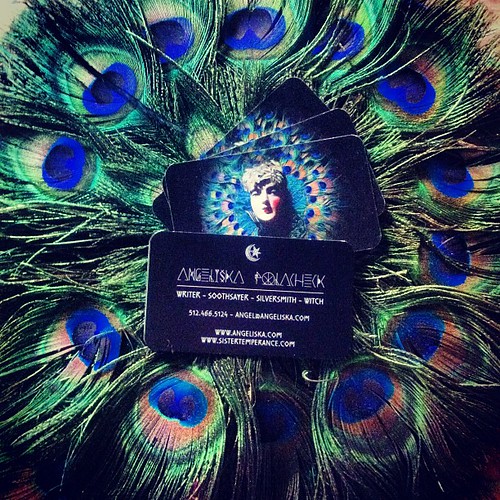
I am indescribably happy with the way these turned out: witchy and sleek and lovely!
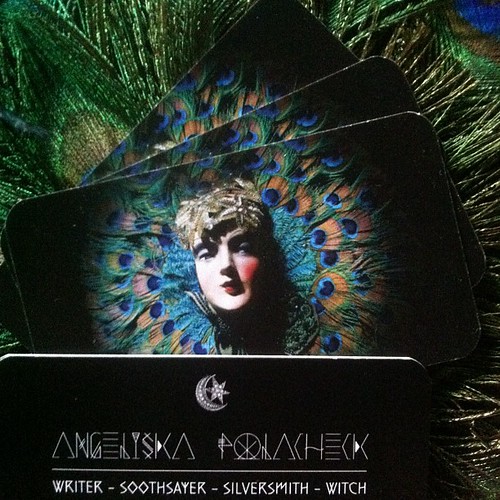
A detail: I took the photograph of one of my boudoir doll heads on an ancient peacock feather fan years ago – knew I was saving it for something extra good…

Moon moth cuffs in process – featured with a garnet moon and star pendant made as gift for my mother by her friend Vernon Reed. I never take it off (except when it was being repaired, here.)
Defining myself as a silversmith was another big step for me: I’ve been making hand fabricated sterling silver jewelry for about three years now (oh gosh, maybe more?) Ridiculously, I have made most pieces as gifts, and eagerly given them to loved ones without always getting decent photos first, so after all this time, I don’t have much to show. Also, my process is pretty laborious, especially since I decided to tackle absurdly ambitious projects for the first few years. Oh, and – I’m super slow and easily distracted! So, whenever I do actually finish a piece, it’s kind of a miracle. I decided this year to focus less on crazy love-objects, and more on jewelry that I could make with an eye towards actually selling.
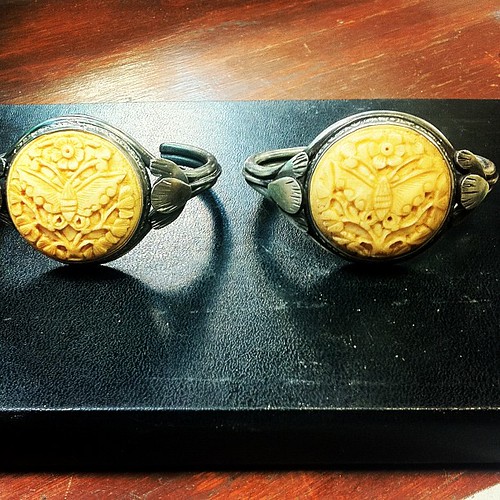
I was so thrilled when I sold my first major piece of jewelry recently, to a lovely and very creative lady, Miss Adrienne Ehler. I met Adrienne a while back when she came to have her cards read, and we’ve stayed in touch since then. She had expressed interest when I posted that the moon moth cuff bracelets were for sale, and has been saving up to buy one ever since. I am incredibly honored and excited that she fell so in love with this piece. I wear mine every single day, and I had hoped that its twin would eventually find its home. Imagine my delight when she contacted me and told me that she wanted to buy it! I love the permanence of working in silver, and the idea that if (heaven forfend) you ever lost one of the pieces, it might be buried for thousands of years under layers of soil and sediment – only to be discovered and marveled at by archaeologists of the future!

I love adding secret details like these roller-pressed leaves to bezel backs – little details that are normally only seen by the wearer. Why leave something plain when it could be beautiful and meaningful?
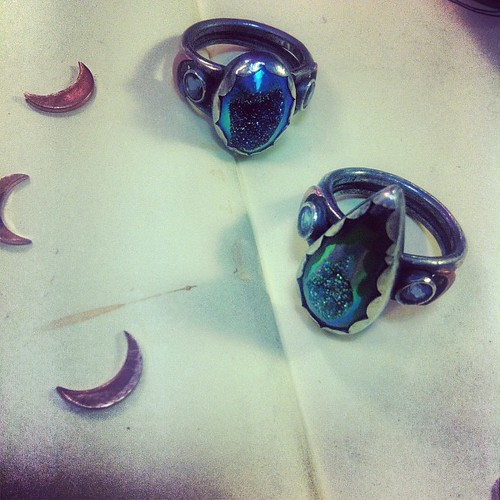
These elfin priestess rings are part of a collection I’m putting together featuring lots of celestial drusy, tube set tanzanites and sapphires and copper moons. I like making jewelry that looks mystical and ancient. Also, each piece is completely individual and made entirely by hand – even the pieces I do multiples of. Nothing is cast, or mass produced – which I have nothing against, but it explains why what I make is so special, and why it will always cost more than a lot of other jewelry out there.
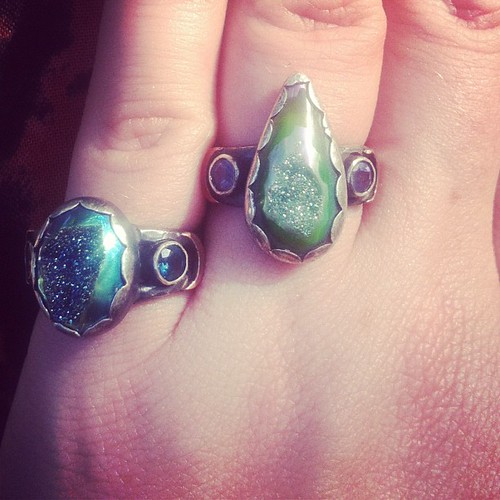
Prices available upon request!
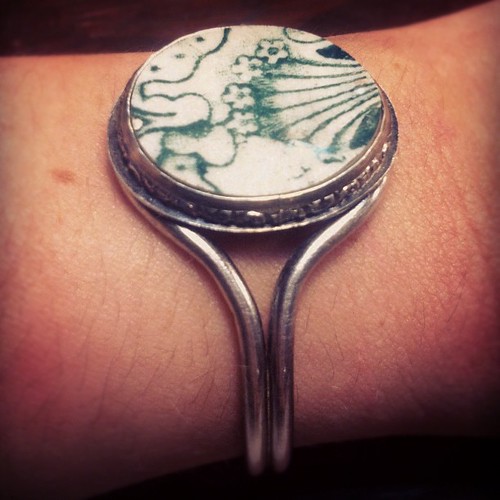
This sterling silver and porcelain cuff was made for my sweet sister Mlle. Dana Sherwood – the china piece was one of many cut into cabochons by my Grampy for my mama back when she was alive and making jewelry. She didn’t live long enough to use them all, so I’ve learned how – to honor her legacy as a jeweler. This little collection of broken plates, collected and saved by my mother, lovingly shaped into ovals and circles by my grandfather is the main reason I make jewelry today. I knew that out of all the legacies she left to me, this one called to me with a voice I couldn’t bear to ignore. Those beautiful pieces didn’t want to stay tucked away in a box forever! Hopefully one day, I’ll be able to do right by her violin and guitar as well.
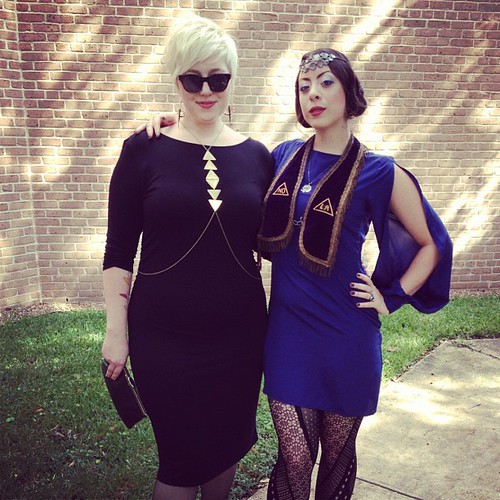
This is how we do it: the delightful Miss Stilwell and I giving haute priestess realness at the Rothko Chapel. I was invited to perform the wedding ceremony for two of our dear friends, Will and Allison.
Ah yes, and the witchery and soothsaying! Two more important words to embrace and uphold: namely by working in service to my community by teaching, reading tarot and performing liminal ceremonies like weddings, baby blessings, and funerals or memorials. So far, it’s only been weddings, but the others are equally important and sacred. I believe strongly that these moments of honoring and crossing over thresholds are best celebrated by someone who truly cares to make the effort for the experience to be both solemn and joyful, magical and heartfelt. Friends keep asking me, and I’m honored every time I get to help make their special day into a memorable ritual.
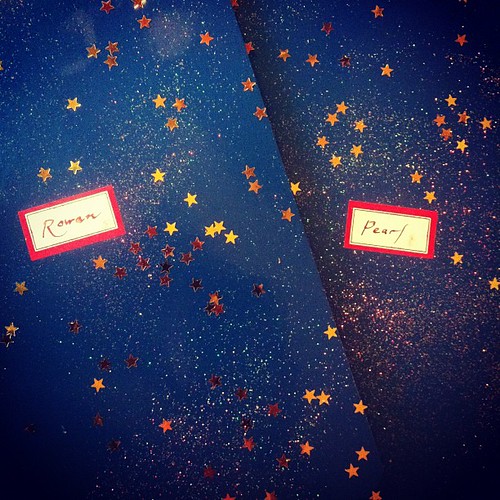
I’m so excited to be resuming teaching tarot and witchery class to my two young students, Rowan & Pearl! I embellished these composition books with gold stars and sparkles for them to write their magical study notes in. They are the cutest little witches ever.
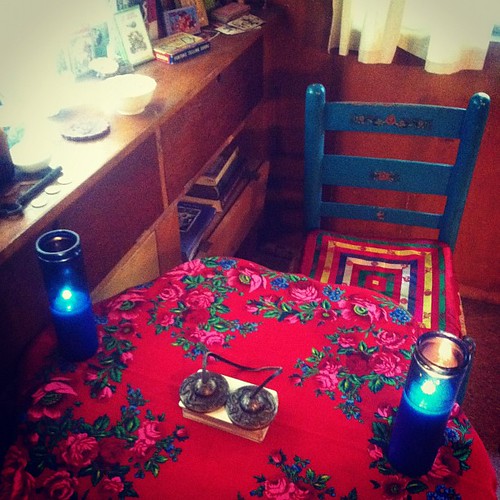
Lau is also working on my Sister Temperance site (what’s up there now is only really a pretty placeholder!), so I’ll soon have a place to devote to my writings on the tarot, and to offering long distance readings for folks who don’t live in Austin. I’m so freaking excited about this, I can barely stand it! I love doing this work more than anything else I’ve ever done. I missed it for years after I left New Orleans – for some reason, for the longest time, I never believed could make a go of it here, but I am being proven wrong!

Once I have a place to put all my tarot musings together, I’ll tell you why I chose Temperance to be my muse and guide in this work! It has always been my most favorite card, out of all the Major Arcana.
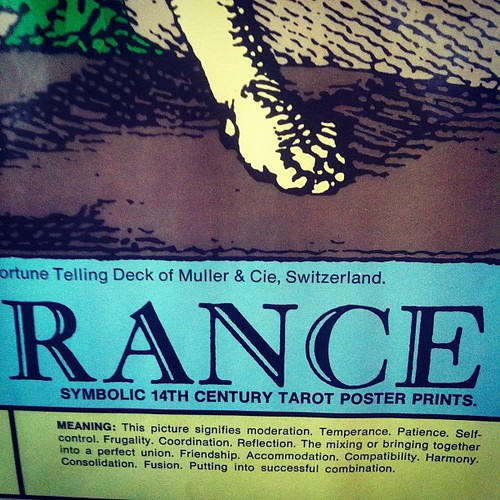
This great old vintage Temperance poster that hangs in my tarot trailer gives only the scantiest of hints…

If you are in Austin, do come visit me for a reading – I make appointments between 2pm and 10pm most days.
Otherwise, keep your eyes peeled for online readings, more jewels for sale, and other witchery!

